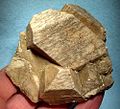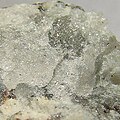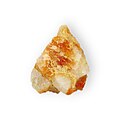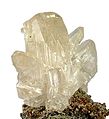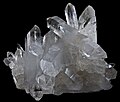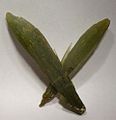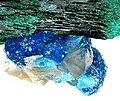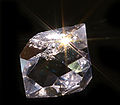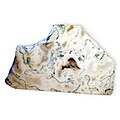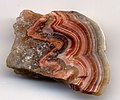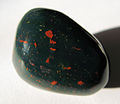User:Chris.urs-o/Sandbox.009
Mineral collection
[edit]Amphiboles, 2012 special procedure
[edit](and IMA mineral list Feb 2013)
- w(OH, F, Cl)-dominant Amphibole Group
- Calcium Amphibole Subgroup
 Done
Done
- Cannilloite homologous series: Cannilloite (Hypothetical), Ferri-cannilloite (Hypothetical), Ferri-fluoro-cannilloite (Hypothetical), Ferro-cannilloite (Hypothetical), Ferro-ferri-cannilloite (Hypothetical), Ferro-ferri-fluoro-cannilloite (Hypothetical), Ferro-fluoro-cannilloite (Hypothetical), Fluoro-cannilloite (1993-033 cannilloite, 2005 s.p., Rd 2012 s.p. ok)
- Edenite homologous series: Edenite (1839, Rd 2012 s.p. ok), Ferro-edenite (1946, Rd 2012 s.p. ok), Ferro-fluoro-edenite (Hypothetical), Fluoro-edenite (1994-059, 2000-049, Rd 2012 s.p. ok), Potassic-ferro-chloro-edenite (Not Approved)
- Hastingsite homologous series: Fluoro-hastingsite (Hypothetical), Hastingsite (1896, Rd 2012 s.p. ok), Magnesio-fluoro-hastingsite (2005-002, Rd 2012 s.p.), Magnesio-hastingsite (1928, Rd 2012 s.p.), Potassic-fluoro-hastingsite (2005-006, Rd 2012 s.p.), Potassic-chloro-hastingsite (2005-007, Rd 2012 s.p.), Potassic-hastingsite (2003, Published without Approval), Potassic-magnesio-hastingsite (2004-027b, Rd 2012 s.p.)
- Joesmithite (1968, Rd 2012 s.p. ok)
- Magnesio-hornblende homologous series: Ferro-ferri-fluoro-hornblende (Hypothetical), Ferro-ferri-hornblende (Hypothetical), Ferro-fluoro-hornblende (Hypothetical), Ferro-hornblende (1930, Rd 2012 s.p. ok), Magnesio-ferri-fluoro-hornblende (Hypothetical), Magnesio-ferri-hornblende (Hypothetical), Magnesio-fluoro-hornblende (1998, Published without Approval), Magnesio-hornblende (1981, Rd 2012 s.p.)
- Pargasite homologous series: Chromio-pargasite (2011-023, Rd 2012 s.p. ok), Ferro-chloro-pargasite (2001, Unnamed - invalid), Ferro-fluoro-pargasite (Hypothetical), Ferro-pargasite (1961, Rd 2012 s.p. ok), Fluoro-pargasite (2003-050, Rd 2012 s.p. ok), Pargasite (1815, Rd 2012 s.p.), Potassic-chloro-pargasite (Approved, Rd 2012 s.p.), Potassic-ferro-pargasite (2007-053, Rd 2012 s.p.), Potassic-fluoro-pargasite (2009-091, Rd 2012 s.p.), Potassic-pargasite (1994-046, Rd 2012 s.p.)
- Sadanagaite homologous series: Ferri-fluoro-sadanagaite (Hypothetical), Ferri-sadanagaite (Hypothetical), Ferro-ferri-fluoro-sadanagaite (Hypothetical), Ferro-ferri-sadanagaite (Hypothetical), Ferro-fluoro-sadanagaite (Hypothetical), Ferro-sadanagaite (sadaganaite, Hypothetical), Fluoro-sadanagaite (Hypothetical), Potassic-chloro-sadanagaite (Hypothetical), Potassic-ferri-sadanagaite (Hypothetical), Potassic-ferro-chloro-sadanagaite (1999, Pending Approval), Potassic-ferro-ferri-sadanagaite (1997-035, 2012 s.p., syn. Potassic-ferrisadanagaite), Potassic-ferro-sadanagaite (1980-027 sadanagaite, 1997 s.p. potassic-sadanagaite, 2012 s.p.), Potassic-sadanagaite (1982-102 magnesiosadanagaite, 1997 s.p. potassic-magnesiosadanagaite, 2012 s.p.), Sadanagaite (1997 s.p., 2003 magnesiosadanagaite, 2012 s.p.)
- Potassic-ferro-ferri-sadanagaite KCa
2(Fe2+
3Fe3+
2)(Si
5Al
3)O
22(OH)
2- Zapiski Vserossiyskogo Mineralogicheskogo Obshchestva 128(4) (1999), 50
- Potassic-ferrisadanagaite IMA 1997-035 KCa
2Fe2+
3Fe3+
2(Si
5Al
3)O
22(OH)
2- Bazhenova A G, Bazhenova L F, Krinova T V, Khvorov P V (1999) Potassicferrisadanagaite (K, Na)Ca2(Fe2+, Al)2[Si5Al3O22](OH)2, a new mineral species of the amphibole group (Ilmen Mountain, the south Urals), Zapiski Vserossijskogo Mineralogicheskogo Obshchestva 128, issue 4, 50-55
- Potassic-ferro-sadanagaite KCa
2(Fe2+
3Al
2)(Si
5Al
3)O
22(OH)
2- American Mineralogist 69 (1984), 465
- Potassicsadanagaite IMA 1980-027 KCa
2Fe2+
3(Al,Fe3+
)
2(Si
5Al
3)O
22(OH)
2- Shimazaki H, Bunno M, Ozawa T (1984) Sadanagaite and magnesio-sadanagaite, new silica-poor members of calcic amphibole from Japan, American Mineralogist 69, 465-471
- Potassic-sadanagaite KCa
2(Mg
3Al
2)(Si
5Al
3)O
22(OH)
2- American Mineralogist 69 (1984), 465
- Potassic-magnesiosadanagaite IMA 1982-102 KCa
2Mg
3Al
2(Si
5Al
3)O
22(OH)
2- Shimazaki H, Bunno M, Ozawa T (1984) Sadanagaite and magnesio-sadanagaite, new silica-poor members of calcic amphibole from Japan, American Mineralogist 69, 465-471
- Sadanagaite NaCa
2(Mg
3Al
2)(Si
5Al
3)O
22(OH)
2- European Journal of Mineralogy 16 (2004), 177
- Magnesiosadanagaite IMA 2002-051 NaCa
2[Mg
3(Fe3+
,Al)
2](Si
5Al
3)O
22(OH)
2- Shimazaki H, Bunno M, Ozawa T (1984) Sadanagaite and magnesio-sadanagaite, new silica-poor members of calcic amphibole from Japan, American Mineralogist 69, 465-471
- Banno Y, Miyawaki R, Matsubara S, Makino K, Bunno M, Yamada S, Kamiya T (2004) Magnesiosadanagaite, a new member of the amphibole group from Kasuga-mura, Gifu Prefecture, central Japan, European Journal of Mineralogy 16, 177-183
- Potassic-ferro-ferri-sadanagaite KCa
- Tremolite-actinolite series pair: Actinolite (1794, Rd 2012 s.p. ok), Ferro-Actinolite (1946, Rd 2012 s.p. ok), Ferro-fluoro-actinolite (Hypothetical), Fluoro-tremolite (2006, Pending Approval), Tremolite (1789, Rd 2012 s.p.)
- Tschermakite homologous series: Ferri-fluoro-tschermakite (Hypothetical), Ferri-tschermakite (1949), Ferro-ferri-fluoro-tschermakite (Hypothetical),
Ferro-Ferri-tschermakite (1978, syn. Ferri-ferrotschermakite), Ferro-fluoro-tschermakite (Hypothetical), Ferro-tschermakite (1973a), Fluoro-tschermakite (Hypothetical), Tschermakite (1945, Rd 2012 s.p.)
- Lithium Amphibole Subgroup
 Done
Done
- Clino-holmquistite homologous series: Clino-ferri-fluoro-holmquistite (Hypothetical), Clino-ferri-holmquistite (Approved 1998, syn. Ferri-ottoliniite), Clino-ferro-ferri-fluoro-holmquistite (Hypothetical), Clino-ferro-ferri-holmquistite (Approved 2001, 2003, Rd 2012 s.p. ok), Clino-ferro-fluoro-holmquistite (Hypothetical), Clino-fluoro-holmquistite (2004, Not Approved), Clino-holmquistite (theoretical name)
- Fluoro-sodic-clinoholmquistite (2002, Not Approved)
- Holmquistite homologous series: Ferri-holmquistite (Hypothetical), Ferro-ferri-holmquistite (Hypothetical), Ferro-holmquistite (2004-030, Rd 2012 s.p. ok), Holmquistite (1913, Rd 2012 s.p. ok)
- Pedrizite homologous series: Ferri-fluoro-pedrizite (Hypothetical), Ferri-pedrizite (2000 sodic-ferripedrizite, 2001-032 ferripedrizite, 2003 s.p. sodic-ferripedrizite, Rd 2012 s.p. ok), Ferro-ferri-fluoro-pedrizite (Hypothetical), Ferro-ferri-pedrizite (2003 sodic-ferro-ferripedrizite, Rd 2012 s.p. ok), Ferro-fluoro-pedrizite (2008-070 Fluoro-sodic-ferropedrizite, Rd 2012 s.p. ok), Ferro-pedrizite (Hypothetical), Fluoro-pedrizite (2004-002 fluoro-sodic-pedrizite, Rd 2012 s.p. ok), Pedrizite (Hypothetical)
- Sodic-ferri-clinoferroholmquistite (1995-045); attention: the original material used to describe clino-ferri-holmquistite by Caballero et al (1998) has been renamed Clino-sodic-ferri-ferroholmquistite.
- Magnesium-iron-manganese Amphibole Subgroup
 Done
Done
- Anthophyllite homologous series: Anthophyllite (1801, Rd 2012 s.p. ok), Ferro-anthophyllite (1921, Rd 2012 s.p. ok), Proto-anthophyllite (2001-065, Rd 2012 s.p.), Proto-ferro-anthophyllite (1986-006, Rd 2012 s.p.), Proto-mangano-ferro-anthophyllite (1986-007, Rd 2012 s.p.)
- Cummingtonite pair: Cummingtonite (1824, Rd 2012 s.p. ok), Manganocummingtonite (1997 s.p.)
- Gedrite pair: Ferro-gedrite (1939, Rd 2012 s.p. ok), Gedrite (1836, Rd 2012 s.p. ok)
- Grunerite pair: Grunerite (1853, Rd 2012 s.p. ok), Manganogrunerite (1997 s.p.)
- Sodic-ferro-anthophyllite (1983, 1997 s.p.)
- Sodic-ferrogedrite (1983, 1997 s.p.)
- Sodicanthophyllite (Hypothetical)
- Sodicgedrite (1983, 1997 s.p.)
- Sodium Amphibole Subgroup
- Arfvedsonite homologous series: Arfvedsonite (1823 ok), Fluoro-arfvedsonite (Hypothetical), Magnesio-arfvedsonite (1998), Magnesio-fluoro-arfvedsonite (1998-056), Mangano-arfvedsonite (1968 kôzulite ???), Potassic-arfvedsonite (2003-043), Potassic-magnesio-arfvedsonite (Published without Approval 2003), Potassic-magnesio-fluoro-arfvedsonite (1985-023)
- Eckermannite homologous series: Eckermannite (1942 ok), Ferro-eckermannite (1964), Ferro-fluoro-eckermannite (Hypothetical), Fluoro-eckermannite (Hypothetical), Potassic-eckermannite (2003, Not Approved)
- Glaucophane homologous series: Ferro-fluoro-glaucophane (Hypothetical), Ferro-glaucophane (1957 ok), Fluoro-glaucophane (Hypothetical), Glaucophane (1963 ok)
- Leakeite homologous series: Ferri-fluoro-leakeite (2009-085 ok), Ferri-leakeite (1991-028, syn. Ferriwhittakerite ok), Ferro-ferri-fluoro-leakeite (1993-026 ok), Ferro-ferri-leakeite (Hypothetical), Ferro-fluoro-leakeite (1996), Ferro-leakeite (Rd 2012 s.p. ???), Fluoro-leakeite (2009-012, syn. Fluoro-aluminoleakeite ok), Leakeite (1992, Rd 2012 s.p. ???), Potassic-ferri-leakeite (2001-049), Potassic-leakeite (2002, Rd 2012 s.p.), Potassic-mangani-leakeite (1992-032 kornite)
- Nybøite homologous series: Ferri-fluoro-nybøite (Hypothetical), Ferri-nybøite (Published without Approval), Ferro-ferri-fluoro-nybøite (Hypothetical), Ferro-ferri-nybøite (2012), Ferro-fluoro-nybøite (Hypothetical), Ferro-nybøite (Hypothetical), Fluoro-nybøite (2002-010 ok), Nybøite (1981)
- Riebeckite homologous series: Fluoro-riebeckite (1966, Published without Approval ok), Magnesio-fluoro-riebeckite (Hypothetical), Magnesio-riebeckite (1949), Riebeckite (1962)
- Sodium-calcium Amphibole Subgroup
- Barroisite homologous series: Barroisite (syn. aluminobarroisite ok), Ferri-barroisite (1978, Rd 2012 s.p.), Ferri-fluoro-barroisite (Hypothetical), Ferro-barroisite (syn. alumino-ferrobarroisite, 1978, 1998, Rd 2012 s.p.), Ferro-ferri-barroisite (syn. Ferro-ferribarroisite, 2006), Ferro-ferri-fluoro-barroisite (Hypothetical), Ferro-fluoro-barroisite (Hypothetical), Fluoro-barroisite (Hypothetical)
- Katophorite homologous series: Ferri-fluoro-katophorite (Hypothetical ok), Ferri-katophorite (1978, syn. magnesio-ferrikatophorite ok), Ferro-ferri-fluoro-katophorite (2012 s.p.), Ferro-ferri-katophorite (1978, syn. ferrikatophorite), Ferro-fluoro-katophorite (Hypothetical), Ferro-katophorite (1894, syn. aluminokatophorite ok), Fluoro-katophorite (Hypothetical), Katophorite (1997, syn. magnesiokatophorite ok), Potassic-ferri-katophorite (Hypothetical), Potassic-fluoro-katophorite (Hypothetical)
- Richterite homologous series: Ferro-fluoro-richterite (Hypothetical), Ferro-richterite (1946 ok), Fluoro-richterite (1992-020 ok), Potassic-ferro-richterite (2008, Not Approved), Potassic-fluoro-richterite (1986-046 potassium-fluor-richterite), Potassic-richterite (1986, Not Approved), Richterite (1865)
- Taramite homologous series: Ferri-fluoro-taramite (Hypothetical), Ferri-taramite (1964 mboziite, syn. magnesio-ferritaramite ok), Ferro-ferri-fluoro-taramite (Hypothetical), Ferro-ferri-taramite (2012 s.p. ok), Ferro-fluoro-taramite (Hypothetical), Ferro-taramite (2006-023 aluminotaramite), Fluoro-taramite (2006-025 fluoro-magnesio-aluminotaramite ok), Potassic-ferri-taramite (Hypothetical), Potassic-ferro-taramite (2007-015 Potassic-aluminotaramite), Taramite (2006-024 magnesio-aluminotaramite)
- Winchite homologous series: Ferri-fluoro-winchite (Hypothetical), Ferri-winchite (2004-034 ok), Ferro-ferri-fluoro-winchite (Hypothetical), Ferro-ferri-winchite (2012 s.p.), Ferro-fluoro-winchite (Hypothetical), Ferro-winchite (2006, syn. alumino-ferrowinchite), Fluoro-winchite (Hypothetical), Winchite (1906, syn. aluminowinchite)
- Hypothetical ?: Ferri-ghoseite (2012 s.p. ok),
- w(O)-dominant Amphibole Group
- Obertite homologous series: Ferri-obertiite (1998-046 ok), Ferro-ferri-obertiite (2009-034 ok)
- Kaersutite homologous series: Ferri-kaersutite (2011-035 ok), Ferro-kaersutite (1978, 1997 s.p.), Kaersutite (1971, 1997 s.p. ok)
- Mangani-dellaventuraite (2003-061 dellaventuraite, 2012 s.p.)
- Mangano-mangani-ungarettiite (1994-004 ungarettiite, 2012 s.p.)
Timeline of the mineral database
[edit]- Introduction
- Golden Book
- The golden stamp book of rocks and minerals (1958) Shaffer, Paul R. (Paul Raymond), Golden Press, pp. 48
- John Sinkankas, Mineralogy: a first course (1966), Van Nostrand, pp. 587.
- 1 ed.: Mineralogy for Amateurs
- Frederick H. Pough, A field guide to rocks and minerals (1960), Houghton Mifflin, pp. 349.
- Dyar, Melinda, Mineralogy And Optical Mineralogy (2007), Mineralogical Society of America, 978-0-939950-81-2
- Golden Book
- Athena
- Dana-system
- Refs
- Forum
- Zeolites of the world, Rudy Tschernich somehow uploaded his entire zeolite bible to Mindat.[1]
-
Various atoms and molecules as depicted in John Dalton's A New System of Chemical Philosophy (1808).
-
Mendeleev's 1871 periodic table.
- Notes
- Type localities:
- Cassiterite was named after an ancient name for the locality of original mining for it, which many historians think was Cornwall.
- Type localities:
- Heilige Dreifaltigkeit Mine, Zschopau, Saxony
- Stamm Asser Mine, Graul, Schwarzenberg District, Erzgebirge, Saxony
- Wismuthzeche, Schneeberg, Saxony
- St. Georg, Schneeberg, Saxony
- Latera caldera, Pitigliano, Tuscany
- Sacrofano caldera, Rome Province, Latium
- Odontolite (fossil tooth, bone) gets blue when heated at 600°C from fluorapatite crystals (Mn5+)
- Diamond: from Greek "adamas", 'invincible'. First known use by Manlius (16 AD) and Pliny (100 AD).
- Heavy spar: baryte
- Scapolite (marialite-meionite series)
People
[edit]- List of minerals named after people
- Biringuccite, Vannoccio Biringuccio (1480–1538/9, 06.EC.05)
- Mohsite, Ilmenite var., Carl Friedrich Christian Mohs (29.Jan.1773 – 29.Sept.1839, 04.CB.05)
- Lacroixite, Antoine François Alfred Lacroix (04.Feb.1863 – 12.March.1948, 08.BH.10)
- Dalyite, Reginald Aldworth Daly (18.Mar.1871 – 19.Sept.1957, 09.EA.25)
- Paulingite-K, Linus Carl Pauling (1901–1994, 09.GC.35)
- Cronstedtite, Axel Fredrik Cronstedt (1722-1765, 09.ED.15), mineralogy
- Annite 09.EC.20, Eliseevite 09.DB.17, Ericaite 06.GA.05, Freyalite* (Melanocerite-(Ce) var., 09.AJ.20), Hannayite 08.CH.35, Khatyrkite 01.AA.15, Margarite 09.EC.30, Marialite (scapolite series), Margarite 09.EC.30, Matildite 02.JA.20, Natalyite (clinopyroxene subgroup); Silvialite 09.FB.15, Simonellite 10.BA.45, Sophiite 04.JG.15, Stephanite 02.GB.10, Susannite 05.BF.40, Vivianite 08.CE.40, Yvonite 08.CB.25
- Jimboite 06.AA.35, Christite 02.HD.15, Christelite (07.DD.25, Commons), Kristiansenite 09.BC.30, Christianite (of Des Cloizeaux, syn. Phillipsite series, Phillipsite-Ca, Phillipsite-K, Phillipsite-Na, 09.GC.10), Ursilite (U-Si), Oursinite 09.AK.10, Bearsite 08.DA.05, Danielsite 02.BD.15
- Navajoite 04.HG.30, Apachite 09.HE.10, Creedite 03.CG.15, Comancheite 03.DD.65, Zunyite 09.BJ.55, Incaite* (Franckeite var., 02.HF.25b), Eskimoite 02.JB.40b, Hashemite 07.FA.15, Vikingite 02.JB.40a, Mongolite 09.HF.05, Yanomamite 08.CD.10, Kalungaite 02.EB.25, Papagoite 09.CE.05, Lennilenapeite 09.EG.40, Changoite 07.CC.50 (Changos people, northern Chile)
Notions
[edit]- Fukuchilite (pyrite group), aenigmatite 09.DH.40, aeschynite-(Ce) 04.DF.05 (shame), cechite ("c'est shit", vanadate), halloysite-7Å/ halloysite-10Å 09.ED.10, bambollaite 02.EB.05b (hot air), banalsite 09.FA.60 (banal), belovite-(Ce)/ belovite-(La) 08.BN.05, tacharanite 09.HA.75 (a changeling), tranquillityite 09.AG.90 (Mare Tranquillitatis (Sea of Tranquility), Moon), tychite 05.BF.05 (luck or chance), griphite 08.BF.15 (puzzle), kainosite-(Y) 09.CF.10 (uncommon), katoptrite 09.AE.40 (mirror), monazite series 08.AD.50 (to be solitary), eucryptite 09.AA.05 (well concealed), eulytine 09.AD.40 (easily fused or dissolved), phenakite 09.AA.05 (deceiver), cacoxenite 08.DC.40 (bad guest), apatiteG 08.BN.05 (to deceive or to be misleading), caryinite 08.AC.10 (κορύινος meaning "in error", the original spelling was changed by Edward Dana in 1892), scrutinyite 04.DB.20 (scrutiny), paragonite 09.EC.15 (misleading), ekplexite 02.?? (surprise), eitelite 05.AC.05 ("Eitel"), trolleite 8.BB.45 (troll), tooeleite 4.JD.15 (too late)
- Coffinite (zircon group), cafetite 04.FL.75, xocolatlite 07.DF.85
- Angelaite 02.JB.25f, angelellite (arsenate), micheelsenite 08.DO.30, gabrielite (02.HD.60)
- Childrenite 08.DD.20, fairfieldite (08.CG.05, Commons), freieslebenite 02.JB.15, gottlobite (vanadate, Commons), liebenbergite (olivine group), menshikovite 02.AC.20c, neighborite 03.AA.35, playfairite 02.LB.30, studtite (uranyl hydroxide), treasurite 02.JB.40a
- Gods of the sea: quetzalcoatlite (Aztec god, 04.FE.45), aegirine (Scandinavian god, 09.DA.25), neptunite (Roman god, 09.EH.05)
- Sea: Halite 03.AA.20, hydrohalite 03.BA.05
Geography
[edit]- Brazilianite (08.BK.05), Switzerite (08.CE.25, Commons)
- USA: Coloradoite 02.CB.05a, IlliteG (micas), Georgiadesite 04.JB.70, Iowaite 04.FL.05, Minnesotaite 09.EC.05, Nevadaite 08.DC.60, Oregonite 02.BB.05, Utahite 07.DE.25
- Brazil: Goyazite 08.BL.10, Paraniite-(Y) 07.GA.15, Paranatisite 09.AG.40b, Minasgeraisite-(Y) 09.AJ.20, Amazonite (Microline var., 09.FA.30), Bahianite 04.DC.05
- Switzerland: Wallisite 02.GC.05, Pizgrischite (Piz Grisch, 02.JA.10d), Grischunite (Grischun, 08.CF.05)
- Localities:
- Europa: Kutnahorite (Kutná Hora, 05.AB.10), Langbanite (Långban, 09.AG.10), Vesuvianite (Mount Vesuvius, 09.BG.35), Alluaivite (Mt. Alluaiv, 09.CO.10), Jachymovite (Jáchymov, 07.EA.10), Lafossaite (La Fossa crater, 03.AA.25), Karnasurtite-(Ce) (Karnasurt Mt, 09.BE.70), Montesommaite (Monte Somma, 09.GB.30), Claraite (Clara mine, 05.DA.30), Capgaronnite (Cap Garonne Mine, 02.FC.20a), Schneebergite (Schneeberg, 08.CG.15), Eifelite (Caspar quarry, 09.CM.05), Harstigite (Harstigen Mine, 09.BF.05), Nyboite (Nybø eclogite pod, 09.DE.25), Koashvite (Koashva Mt, 09.CJ.15c), Lengenbachite (Lengenbach quarry, 02.HF.30), Hundholmenite-(Y) (Hundholmen, 09.AJ.35), Tuzlaite (Tuzla, 06.EC.25), Montebrasite (Montebras-en-Soumans, 08.BB.05), Chegemite (Upper Chegem caldera, Northern Caucasus Region, 09.??), Elbaite (Elba Island, 9.CK.05), Balkanite (Balkan Mountains, 02.BD.15), Tinzenite (Tinizong (Tinzen), Grischun, 09.BD.20), Terskite (Tersk (Kola peninsula), 09.DM.40), tuscanite (Tuscany, 09.EG.45), grimselite (Grimsel Pass, 05.ED.35)
- Middle East: hatrurite (Hatrurim Formation, 09.AG.65),
- Asia: ximengite (Ximeng Co., 08.AD.45), qusongite (Qusong Co., WC, 01.BA.25), fukalite (Fuka Mine, 09.DQ.05), ningyoite (Ningyo-toge mine, 08.CJ.85), darapiosite (Dara-Pioz massif, 09.CM.05), horomanite (Horoman, 02.XX.00), baghdadite (Baghdad, Iraq, 09.BE.17), tokyoite (Tokyo prefecture, 08.BG.05), tolbachite (Large Fissure Tolbachik eruption, Kamchatka, 03.AB.05), srilankite (Sri Lanka, 04.DB.25), sinhalite (sanskrit for Sri Lanka, 06.AC.05)
- Africa: tsumebite (Tsumeb, 08.BG.05), kobokoboite (Kobokobo pegmatite, 08.), tunisite (Tunisia, 05.BB.15),
- America: Minasragrite (Minasragra, 07.DB.20), Moctezumite (Moctezuma Mine, 04.JK.65), Poudretteite (Poudrette quarry, 09.CM.05), Searlesite (Searles Lake, 09.EF.15), Clearcreekite (Clear Creek Mine, 05.DC.30), Footemineite (Foote Mine, 08.DA.10), Tiptopite (Tip Top Mine, 08.DA.25), Narsarsukite (Narssârssuk pegmatite, 09.DJ.05), Sterlinghillite (Sterling Hill, 08.CD.25), Franklinite (Franklin Furnace, 04.BB.05), Cummingtonite (Cummington, 09.DE.05), Wakefieldite (Lac Saint-Pierre (Wakefield Lake), 08.AD.35), Terlinguaite (Terlingua Mining District, 03.DD.20), Tripuhyite (Tripuí (Tripuhy), Ouro Preto, 04.DB.05), Colimaite (Colima (volcano), 02.FB.25), cleavelandite (albite var., 09.FA.35)
Important minerals
[edit]Economic geology
[edit]Rock salt; gold & silver (copper group); precious and semi-precious gems; platinum group; stone age (flints); copper age (chalcocite/ chalcopyrite); bronze age (tin & copper, cassiterite); iron age; ceramic (pottery and porcelain) and cement; coal, petroleum, oil shale, gas; steel (nickel, vanadium); radioactive materials; space technology (chromium, titanium, tungsten, molybdenum); rare earth elements (REE).
- 2 Alite + 6 water → C-S-H + 3 portlandite
- Belite + water → C-S-H phase + portlandite
- Forsterite + water → serpentine + brucite
- Mullite or porcelainite is a rare silicate mineral of post-clay genesis.
- Bone china consists of two crystalline phases, anorthite and ß-tricalcium phosphate.
- USA Minerals Production (2004) [2]
- Middle
- Arkansas: Bromine, cement (portland), lime.
- Illinois: Cement (portland), lime.
- Indiana: Cement (portland), lime, cement (masonry).
- Iowa: Cement (portland), gypsum (crude), lime.
- Kansas: Cement (portland), helium (Grade-A), salt, helium (crude).
- Kentucky: Lime, cement (portland), clays (ball).
- Michigan: Iron ore (usable), cement (portland), salt.
- Minnesota: Iron ore (usable), stone (dimension).
- Missouri: Cement (portland), lead, lime.
- Nebraska: Cement (portland), cement (masonry), lime.
- North Dakota: Lime, clays (common).
- Ohio: Salt, lime, cement (portland).
- Oklahoma: Cement (portland), gypsum (crude).
- Pennsylvania: Cement (portland), lime, cement (masonry).
- South Dakota: Cement (portland), gold, stone (dimension).
- Tennessee: Cement (portland), clays (ball).
- Wisconsin: lime, sand and gravel (industrial).
- East
- Northeastern
- Connecticut: Stone (dimension), clays (common), gemstones (natural).
- Maine: Cement (portland), stone (dimension), cement (masonry).
- Massachusetts: Lime, stone (dimension), clays (common).
- New Hampshire: Stone (dimension), gemstones (natural).
- Rhode Island: Gemstones (natural).
- Vermont: Stone (dimension), talc (crude), gemstones (natural).
- New Jersey: Greensand marl, peat.
- New York: Salt, cement (portland), wollastonite.
- Pennsylvania: Cement (portland), lime, cement (masonry).
- East coast (rest)
- Delaware: magnesium compounds, gemstones (natural).
- Maryland: Cement (portland), stone (dimension), cement (masonry).
- Virginia: Cement (portland), lime, zirconium (concentrates).
- West Virginia: Cement (portland), lime, cement (masonry).
- North Carolina: Phosphate rock, feldspar.
- South Carolina: Cement (portland), cement (masonry), clays (kaolin).
- Georgia: Clays (kaolin), clays (fuller's earth), cement (portland).
- Northeastern
- Gulf of Mexico
- Alabama: Cement (portland), lime, cement (masonry).
- Florida: Phosphate rock, cement (portland), cement (masonry).
- Louisiana: Salt, clays (common).
- Miississippi: Clays (fuller's earth), cement (portland), clays (bentonite).
- Texas: Cement (portland), salt, lime.
- West
- Arizona: Copper, molybdenum concentrates, cement (portland).
- California: Cement (portland), boron minerals, diatomite.
- Colorado: Molybdenum concentrates, cement (portland), gold.
- Idaho: Molybdenum concentrates, phosphate rock, silver, cement (portland).
- Montana: Platinum metal, palladium metal, copper, molybdenum concentrates.
- Nevada: Gold, lime, silver.
- New Mexico: Copper, potash, molybdenum (concentrates), cement (portland).
- Oregon: Cement (portland), diatomite, lime.
- Utah: Copper, molybdenum (concentrates), cement (portland), gold.
- Washington: Cement (portland), gold, zinc.
- Wyoming: Soda ash, clays (bentonite), helium (Grade-A), cement (portland).
- Alaska and Hawaii
- Alaska: Zinc, lead, gold, silver.
- Hawaii: Gemstones (natural).
- Middle
Five great minerals
[edit]Quartz/ mogánite, feldspar (albite, anorthite and orthoclase solid solution series), calcite/ aragonite/ dolomite, olivine (forsterite (Mg-dominant) and fayalite (Fe-dominant) solid solution series), chalcocite/ chalcopyrite, diamond/ graphite. [3] (modified)
Fifty great minerals
[edit]Andalucite, Apatite, Barite, Beryl, Biotite, Chromite, Chrysotile, Cordierite, Corundum, Diamond, Dolomite, Florencite, Galena, Garnet, Graphite, Gypsum, Halite, Hematite, Hornblende, Illite, Illmenite, Kaolinite, Kyanite, Lepidolite, Limonite, Magnetite, Molybdenite, Monazite, Nepheline, Olivine, Omphacite, Opal, Perovskite, Plagioclase, Pyrite, Quartz, Rutile, Sanidine, Sillimanite, Silver (native), Sphalerite, Staurolite, Sulphur (native), Talc, Tourmaline, Tremolite, Turquoise, Vermiculite, Willemite, Zeolite, Zircon. [4]
More than hundred great minerals
[edit]- Rock-forming minerals: abundant and widespread minerals.
- AmphibolesG: actinolite (in metamorphic rocks), glaucophane (in subducted basalts), hornblendeG
- BiotiteG (black mica of igneous rocks)
- Calcite ("old" seafloor sediment)
- Dolomite ("nowadays" seafloor sediment)
- FeldsparsG: plagioclaseG (solid solution series between albite and anorthite), alkali feldsparG (in granites, solid solution series between albite and potassium-feldspar (k-spar))
- Muscovite (white mica)
- OlivineG: solid solution series between forsterite (Mg-endmember) and fayalite (Fe-endmember)
- PyroxenesG: aegirine, augite (in igneous rocks), bronzite (a variety of enstatite), diopside, enstatite, jadeite (gemstone), omphacite (a green pyroxene of high-grade metamorphics), spodumene.
- Quartz/ mogánite
- Accessory minerals: minerals that are widespread and significant but rarely abundant.
- Andalusite; Anhydrite (what gypsum becomes deep underground); Apatite; Aragonite; Barite; Bornite; Cassiterite (tin ore); Chalcopyrite (copper ore); Chlorite (of metamorphic rocks); Corundum (varieties: sapphire and ruby), Epidote (metamorphic mineral), Fluorite, Galena (lead ore); Garnet: Almandine (true "garnet-red"), Andradite (green crystals), Grossular (greenish), Pyrope (wine-colored grains in eclogite), Spessartine (honey-colored), Uvarovite (emerald-green); Goethite (iron ore); Graphite; Gypsum; Halite (rock salt); Hematite; Ilmenite (black titanium ore); Kyanite (a sky-blue mineral formed by high-pressure metamorphism); Lepidolite (lithium mica mineral with a fine lilac color); Leucite (feldspathoid mineral); Magnetite; Marcasite; Nepheline (feldspathoid mineral); Phlogopite (brown mica); Prehnite (bottle-green mineral of low-grade metamorphic rocks); Psilomelane ; Pyrite (sulfide mineral); Pyrolusite (the black manganese mineral of dendrites); Rutile needles (oxide mineral); Serpentine group (green minerals that yields asbestos); Sillimanite (indicator mineral for high grades of metamorphism); Sphalerite (zinc ore); Spinel (of metamorphosed limestones); Staurolite (of a mica-schist matrix); Talc; Tourmaline group; Zeolite family; Zircon
- Uncommon minerals and varieties: rare and sometimes valuable minerals.
- Amethyst (a variety of quartz); Axinite; Benitoite; Beryl (gemstone); Borax (evaporite); Celestine (pale, sky-blue strontium mineral); Cerussite (lead carbonate); Chrysocolla; Cinnabar (mercury ore); Copper; Cuprite; Diamond; Dioptase; Dumortierite (blue boron mineral of gneisses and schists); Eudialyte (striking red vein-maker in nepheline syenites); Fuchsite (a flashy green Cr-bearing muscovite variety); Gold; Hemimorphite (hydrous zinc silicate); "Herkimer Diamond" Quartz (doubly terminated crystals from New York); LabradoriteI; Lazurite; Magnesite (magnesium carbonate); Malachite (copper carbonate); Molybdenite (molybdenum ore); Opal (gemstone, silica mineraloid); Platinum; Pyromorphite (flashy green lead phosphate); Pyrophyllite; Rhodochrosite; Ruby (a variety of corundum), Scapolite (crystals of metamorphosed limestones); Siderite (iron carbonate); Silver; Smithsonite (carbonate of zinc); Sodalite (feldspathoid); Sulfur (sulphur); Sylvite; Titanite; Topaz (gemstone); Turquoise (gemstone); Ulexite ("TV rock"); Variscite; Willemite; Witherite (barium carbonate).[5] [6]
500 important minerals on sale
[edit]- Aggregates: opal (a valid IMA species name and a mineraloid), odontolite, lapis lazuli
- Hydrocarbons: oil shale, clathrate hydrate, ozocerite, petroleum and coal
- Biological origin: amber, coral
- Chrysocolla (a valid IMA species name, it's suggested that it is mixture of spertiniite and chalcedony or opal, similarities with copper-bearing allophane)
- Ores:
- Groups of "brotherly elements":
- Te, Bi, Au; Si, Al3+, Be, Ti, Cr3+, Zr, B, Ge; Zr, U; Th, REE; Ca2+, Mg2+, Pb, Sr2+, Zn2+, Ba2+, Co2+; Fe, Mn, Ni, Cr; S, Te, Sb, As, Se; Na, K; Cu, Ag, Au; F, Cl, Br; (PO4)3-, (AsO4)3-, (VO4)3-;
- Copper-cupalite family (Al, Cu, Au, Ag, Pb, Ni); zinc-brass family (Cu-Zn alloys; Cd, Re, Zn, Ti); indium-tin family (In, Sn); mercury-amalgam family (Hg, Cu, Pb, Ag, Au, Pd); iron-chromium family (Mo, Cr, Fe, W, Ni, Co, Ta, Nb, Mn); platinum-group elements (PGE; Os, Ru, Ir, Pd, Pt, Rh); rare earth elements (REE; Sc, Y, La, Ce, Pr, Nd, Pm, Sm, Eu, Gd, Tb, Dy, Ho, Er, Tm, Yb, Lu); arsenic group elements (Sb, As, Bi); sulfur-selenium-iodine (S, Se, Te, I)
- Hematite, magnetite (Fe); cassiterite (Sn); chalcocite, chalcopyrite (Cu); ilmenite (Ti); pentlandite (Ni); sphalerite (Zn); bauxite (Al, a mixture of: böhmite, diaspore, gibbsite); cinnabar (Hg); chromite, magnesiochromite (Cr); molybdenite (Mo); scheelite (W); V-bearing magnetite (V); acanthite (Ag); uraninite (U);
- Groups of "brotherly elements":
- Anthropogenic material on sale
- Diamond simulants: yttrium aluminium garnet (YAG), strontium titanate (fabulite), gadolinium gallium garnet (GGG, galliante), cubic zirconia (CZ, djevalite), synthetic moissanite (silicon carbide, carborundum)
- Ceramic, terracota, earthware, stoneware, porcelain and cement industry:
- 2 Alite + 6 water → C-S-H + 3 portlandite
- Belite + water → C-S-H phase + portlandite
- Forsterite + water → serpentine + brucite
- Earthware: generic composition is 25% ball clay, 28% kaolin, 32% quartz and 15% feldspar.
- Stoneware: generic composition is plastic fire clays 0–100% (Al2O3.2SiO2.2H2O), ball clays 0–15%, quartz 0–30%, feldspar and chamotte (grog, more or less crushed fired pottery) 0 –15%.
- Weathering: K-feldspar (potash feldspar) + CO2 + 2H2O --> kaolinite + 4SiO2
- Drying under 150°C; dehydration under 600°C; calcination of e.g. CaCO3 between 600 to 900°C; oxidation of ferrous and organic matter between 350 to 900°C; formation of silicate above c. 900°C
- Kaolinite (600 to 650°C) --> alumina + 2SiO2 + 2H2O
- Amorphous alumina (940°C) --> γ-alumina
- Kaolinite --> mullite + 4SiO2 (cristobalite) + 6H2O
- Mullite (porcelainite) is a rare silicate mineral of post-clay genesis.
- Mineral class native elements:
(Note: very rare minerals, synthetic samples are quite common)- 01.A Metals and Intermetallic Alloys
- 01.AA Copper-cupalite family: native copper, lead, native gold, native silver, nickel, aluminum
- 01.AB Zinc-brass family (Cu-Zn alloys): cadmium, zinc, titanium
- 01.AC Indium-tin family: indium, tin
- 01.AD Mercury-amalgam family: mercury
- 01.AE Iron-chromium family: iron, chromium
- 01.AF Platinum-group elements (PGE): osmium, ruthenium, palladium, iridium, rhodium, platinum
- 01.B Metallic Carbides, Silicides, Nitrides and Phosphides
- 01.BA Carbides: cohenite (syn. cementite), khamrabaevite (syn. titanium carbide), moissanite (syn. silicon carbide)
- 01.C Metalloids and Nonmetals
- 01.A Metals and Intermetallic Alloys
Non silicates
[edit]- Nickel-Strunz class 02.A to 02.E:
- Molybdenite, covellite, stibnite, acanthite, krennerite, bismuthinite, sylvanite, emplectite, argyrodite, germanite, pentlandite, pyrrhotite, cubanite, chalcopyrite, millerite, bornite, chalcocite, dyscrasite, galena, calaverite, linnaeite, pyrite, marcasite, sperrylite, rammelsbergite, löllingite, nickelskutterudite, maucherite, safflorite, skutterudite, tetradymite, stannite, sphalerite
- Polymorphs: cinnabar, hypercinnabar, metacinnabar
- Nickel-Strunz class 02.F to 02.M:
- Polybasite, boulangerite, jamesonite, bournonite, meneghinite, nagyagite, stephanite, tennantite, tetrahedrite (var. mercurian tetrahedrite, schwazite), enargite, freibergite, jordanite, arsenopyrite, gersdorffite, ullmannite, cobaltite
- Nickel-Strunz class 03:
- Nickel-Strunz class 04:
- Periclase, anatase, perovskite, brookite, cassiterite, tenorite, bixbyite, ilmenite, pyrolusite, psilomelane, thorianite, uraninite, kermesite, cuprite, zincite, rutile, euxenite, hematite
- Pyrochlore mineral supergroup
- PyrochloreG: oxycalciopyrochlore
- Note on betafite: old samples belong mostly to the pyrochlore mineral group
- MicroliteG: fluornatromicrolite, oxycalciomicrolite, hydroxykenomicrolite
- PyrochloreG: oxycalciopyrochlore
- 04.DB.35 TantaliteG: tantalite-(Fe), tantalite-(Mg), tantalite-(Mn)
- 04.DB.35 ColumbiteG: columbite-(Fe), columbite-(Mg), columbite-(Mn)
- 04.BB Spinel mineral group: spinel, hausmannite, franklinite, magnetite
- Corundum: var. ruby, var. saphire
- Nickel-Strunz class 04 (hydroxides):
- Nickel-Strunz class 04 (arsenites, antimonites, bismuthites, sulfites, selenites, tellurites):
- Nickel-Strunz class 05:
- Nickel-Strunz class 06:
- Nickel-Strunz class 07:
- Epsomite, aluminite, halotrichite, gypsum, kainite, glauberite, thenardite, variscite, alunite, anhydrite, polyhalite, kieserite, coelestine, anglesite, barite, devilline, tyrolite, brochantite, jarosite, chalcanthite, cyanotrichite, linarite, caledonite, serpierite, connellite
- Nickel-Strunz class 07 (chromates, molybdates, wolframates, niobates):
- Wolframite, hübnerite, crocoite, stolzite, wulfenite, scheelite, powellite
- Wolframite: hübnerite and ferberite series
- 07.GA.05 FergusoniteG: fergusonite-(Ce), fergusonite-(Y)
- Wolframite, hübnerite, crocoite, stolzite, wulfenite, scheelite, powellite
- Nickel-Strunz class 08:
- Struvite, wavellite, strengite, ludlamite, triphylite, adamine, pyromorphite, amblygonite, beryllonite, wardite, turquoise, brazilianite, lazulite, libethenite, dufrénite, pseudomalachite, purpurite, heterosite, cacoxenite, vivianite
- Autunite mineral group: uranocircite, zeunerite, torbernite, autunite
- ApatiteG: hydroxylapatite, fluorapatite, chlorapatite
- MonaziteG: monazite-(Ce), monazite-(La), monazite-(Nd), monazite-(Sm)
- Nickel-Strunz class 08 (arsenates):
- Nickel-Strunz class 04 (V(5+, 6+) vanadates) and 08 (vanadates):
- Nickel-Strunz class 10:
Silicates
[edit]- 09.A Subclass Nesosilicates:
- Zircon, euclase, braunite, dumortierite, magnesiodumortierite,
- 09.AA. Phenakite mineral group: willemite, phenakite
- 09.AC.05 OlivineG: solid solution series between forsterite (Mg-endmember) and fayalite (Fe-endmember)
- 09.AD.25 GarnetG: pyrope, almandine, spessartine, grossular, andradite, uvarovite
- 09.AF.: topaz, humite, staurolite, magnesiostaurolite, zincostaurolite, chondrodite, hydroxylchondrodite, manganhumite, unnamed (Ca-analogue of humite), clinohumite, mullite
- Polymorphs: kyanite, andalusite, sillimanite
- 09.AG.: titanite, natrotitanite
- 09.AJ. Gadolinite-datolite group: datolite, gadolinite-(Ce), gadolinite-(Y), calciogadolinite-(Y)
- 09.B Subclass Sorosilicates:
- Hemimorphite, bertrandite,
- 09.BG.35 Vesuvianite mineral group: vesuvianite, fluorvesuvianite, manganvesuvianite
- Epidote mineral group: epidote, epidote-(Pb), epidote-(Sr), clinozoisite, clinozoisite-Sr, zoisite, piemontite, piemontite-(Pb), piemontite-(Sr), manganipiemontite-(Sr)
- AllaniteG: allanite-(Ce), allanite-(La), allanite-(Nd), allanite-(Y)
- 09.BB.10 MeliliteG: åkermanite, gehlenite
- 09.BD.20 AxiniteG: axinite-(Fe), axinite-(Mg), axinite-(Mn)
- 09.BE.07: ilvaite, manganilvaite
- 09.BD.50 Kornerupine-prismatine series
- 09.C Subclass Cyclosilicates:
- Milarite, benitoite, eudialyte, dioptase
- Cordierite-sekaninaite series
- 09.CK.05 TourmalineG: achroite (usually a clear elbaite), dravite (brown), elbaite, schorl (black), verdelite (usually a green lithium-rich tourmaline), indicolite (usually a blue elbaite), rubellite (usually a red elbaite)
- 09.CJ.05 Beryl: aquamarine (blue), emerald (green), goshenite (clear), gold-beryll, heliodor (yellowish green), morganite (rose to violet)
- 09.D Subclass Inosilicates:
- Prehnite, charoite, astrophyllite,
- 09.DG.05 Wollastonite mineral group: wollastonite
- Rhodonite (low-pressure, high-temperature polymorph of pyroxmangite)
- Pyroxferroite-pyroxmangite series: pyroxmangite (high-pressure, low-temperature polymorph of rhodonite)
- Carpholite mineral group: carpholite, ferrocarpholite, magnesiocarpholite, potassiccarpholite, vanadiocarpholite
- Pyroxene mineral supergroup
- Clinopyroxene group (monoclinic): jadeite, aegirine, augite
- Enstatite-ferrosilite series: var. bronzite c. 12 - 25% FeSiO3, var. hypersthene 25 - 50% FeSiO3
- Hedenbergite-johannsenite series, diopside-hedenbergite series
- Orthopyroxene group (orthorhombic): augite (var. fassaite), spodumene,
- Clinopyroxene group (monoclinic): jadeite, aegirine, augite
- Amphibole mineral supergroup: glaucophane, anthophyllite
- Magnesioriebeckite-riebeckite series
- Tremolite-ferro-actinolite series: actinoliteI (a valid IMA species name and an intermediate member of a series)
- Arfvedsonite-magnesio-arfvedsonite series
- HornblendeG, informal group: ferrohornblende, magnesiohornblende
- 09.E Subclass Phyllosilicates:
- Okenite, petalite,
- 09.EA.15 ApophylliteG: apophyllite-(KF), apophyllite-(KOH), apophyllite-(NaF)
- 09.EE: gyrolite, sepiolite, palygorskite
- 09.EH.05: neptunite, manganoneptunite, magnesioneptunite
- 09.EC and ED Phyllosilicates with mica sheets or kaolinite layers
- IlliteG, informal group: margarite,
- Muscovite (fuchsite, a green Cr-bearing var.)
- BiotiteG: solid-solution series between the iron-endmember annite, and the magnesium-endmember phlogopite; more aluminous endmembers include siderophyllite.
- LepidoliteG: polylithionite-trilithionite series
- SmectiteG: montmorillonite, nontronite, saponite
- Montmorillonite-vermiculite mineral group
- Beidellite-montmorillonite series
- Chlorite mineral group:
- Chinochlore-chamosite series: var. chromian chinochlore (kämmererite)
- 09.ED.05: kaolinite, dickite (a valid IMA species name and kaolinite var.), nacrite (a valid IMA species name and kaolinite var.)
- 09.ED.15 SerpentineG: antigorite, chrysotile, cronstedtite
- Pyrohyllite-talc mineral group: pyrophyllite, willemseite, talc
- Note:
- GarnieriteG, informal group: willemseite, népouite, nickel dominant smectite (pimelite?)
- Hypothesis:
- Feldspar (weathering, mainly in the tropics) --> amorphous/ poorly-crystalline allophane
- Tuff (weathering, mainly in the tropics) --> bauxite + weathered feldspar
- Amorphous/ poorly-crystalline allophane + SiO2 --> halloysite
- Amorphous/ poorly-crystalline allophane --> gibbsite + SiO2
- Amorphous/ poorly-crystalline allophane --> imogolite nanotubes
- IlliteG, informal group: margarite,
- 09.F Subclass Tectosilicates
- Danburite, nepheline,
- 09.FA. FeldsparsG
- PlagioclaseG (solid solution series between albite and anorthite): pericline, oligoclase, sunstone, andesine, labradorite, bytownnite
- Alkali feldsparG (solid solution series between albite and potassium-feldspar (k-spar)): microcline, sanidine, adularia, moonstone, amazonite
- 09.FB.15 ScapoliteG: marialite-meionite series
- 09.FB. Sodalite mineral group: sodalite, haüyne, lazurite, nosean
- 09.G Subclass Tectosilicates, zeolite family:
- Natrolite mineral subgroup: mesolite, laumontite, scolecite, natrolite, harmotome, gonnardite, leucite,
- 09.GA.10 ThomsoniteG: thomsonite-Ca, thomsonite-Sr
- 09.GB.05 Analcime-pollucite series
- 09.GC.10 PhillipsiteG: phillipsite-Ca, phillipsite-K, phillipsite-Na
- 09.GD.05 GmeliniteG: gmelinite-Ca, gmelinite-K, gmelinite-Na
- 09.GD.10 ChabaziteG: chabazite-Ca, chabazite-K, chabazite-Mg, chabazite-Na, chabazite-Sr
- 09.GE.05 HeulanditeG: heulandite-Ba, heulandite-Ca, heulandite-K, heulandite-Na, heulandite-Sr
- 09.GE.10 StilbiteG: stilbite-Ca, stilbite-Na
- Natrolite mineral subgroup: mesolite, laumontite, scolecite, natrolite, harmotome, gonnardite, leucite,
- Others
- 04.DA Silica family:
- Reference: Schumann, Walter (1991) BLV Bestimmungsbuch, Mineralien aus aller Welt, BLV Verlagsgesellschaft mbH
Informal groups
[edit]- Omphacite: a clinopyroxene solid solution of jadeite (25%-75%), augite (25%-75%), and aegirine (0%-25%). Retained as a distinct species for practical reasons.
- Smectite group: monoclinic clay-like minerals
- Most commmon members: montmorillonite, nontronite and saponite
- Aliettite, beidellite, ferrosaponite, hectorite, nontronite, pimelite, saliotite, saponite, sauconite, stevensite, swinefordite, volkonskoite, yakhontovite, zincsilite
- Structurally related to group
- Montmorillonite-vermiculite Group
- Beidellite-montmorillonite series
- Feldspathoid group, informal group (silica deficient alkali feldspars).
- Tectosilicates: feldspathoid mineral + silica gives feldspar
- Feldspathoid: Al:Si (1:1), feldspar: Al:Si (1:3)
- Nepheline + quartz ---> alkali feldspar
- Leucite + quartz ---> K-feldspar
- Sodalite group (Na8(AlSiO4)6Cl2),
- Analcime, cancrinite (Na6Ca2(AlSiO4)6(CO3)2), nepheline group (NaAlSiO4), leucite (c. KALSi2O6), noselite, melilite
- Mica group, illite group. This clay-like series is essentially a K-deficient muscovite, of uncertain status.
- Aluminoceladonite (09.EC.15), Anandite (09.EC.35), Aspidolite (09.EC.20), Biotite group (commonly used for Phlogopite (09.EC.20), Fluorophlogopite (09.EC.20), Fluorotetraferriphlogopite (09.EC.20), Siderophyllite (09.EC.20), Annite (09.EC.20), Fluorannite (09.EC.20), Tetra-ferri-annite (09.EC.20), Eastonite (09.EC.20), Bityite (09.EC.35), Boromuscovite (09.EC.15), Celadonite (09.EC.15), Chernykhite (09.EC.15), Chromceladonite (09.EC.15), Chromphyllite (09.EC.15), Clintonite (09.EC.35), Ephesite (09.EC.20), Ferro-aluminoceladonite (09.EC.15), Ferroceladonite (09.EC.15), Ferrokinoshitalite (09.EC.35), Ganterite (09.EC.15), Glauconite (09.EC.??), Hendricksite (09.EC.20), Kinoshitalite (09.EC.35), Lepidolite (polylithionite (09.EC.20) - trilithionite (09.EC.20) series), Luanshiweiite-2M1 (09.EC.??), Margarite (09.EC.30), Masutomilite (09.EC.20), Montdorite (09.EC.15), Muscovite (09.EC.15), Nanpingite (09.EC.15), Norrishite (09.EC.20), Oxykinoshitalite (09.EC.35), Oxyphlogopite (09.EC.20), Phengite (muscovite (09.EC.15) - celadonite (09.EC.15) series), Phlogopite (09.EC.20), Polylithionite (09.EC.20), Preiswerkite (09.EC.20), Roscoelite (09.EC.15), Shirokshinite (09.EC.20), Shirozulite (09.EC.20), Siderophyllite (09.EC.20), Sokolovaite (09.EC.20), Suhailite (09.EC.20), Tainiolite (09.EC.15), Tetraferriphlogopite (09.EC.20), Tobelite (09.EC.15), Trilithionite (09.EC.20), Voloshinite (09.EC.??), Yangzhumingite (09.EC.20), Zinnwaldite (siderophyllite (09.EC.20) - polylithionite (09.EC.20) series)
- Zeolite family, natrolite group.
- 09.GA: Zeolites with T5O10 Units – The Fibrous Zeolites; 09.GB: Chains of single connected 4-membered rings; 09.GC: Chains of doubly-connected 4-membered rings; 09.GD: Chains of 6-membered rings – tabular zeolites; 09.GE: Chains of T10O20 Tetrahedra; 09.GF: Other Rare Zeolites; 09.GG: Unclassified zeolites
- Gmelinite-offretite subgroup, Harmotome-phillipsite-Ca series, Chabazite-levyne subgroup, Clinoptilolite-Ca-Heulandite-Ca Series; Clinoptilolite-K-Heulandite-K Series; Clinoptilolite-Na-Heulandite-Na Series
- Alflarsenite (09.G?), Amicite (09.GC.05), Ammonioleucite (09.GB.05), Analcime (09.GB.05), Barrerite (09.GE.15), Bellbergite (09.GD.20), Bikitaite (09.GD.55), Boggsite (09.GC.30), Brewsterite (09.GE.20, Brewsterite-Ba, Brewsterite-Sr), Chabazite (09.GD.10, Chabazite-Ca, Chabazite-K, Chabazite-Mg, Chabazite-Na, Chabazite-Sr), Chiavennite (09.GF.25), Clinoptilolite (09.GE.05, Clinoptilolite-Ca, Clinoptilolite-K, Clinoptilolite-Na), Cowlesite (09.GG.05), Dachiardite (09.GD.40, Dachiardite-Ca, Dachiardite-Na), Direnzoite (09.GF.55), Edingtonite (09.GA.15), Epistilbite (09.GD.45), Erionite (09.GD.20, Erionite-Ca, Erionite-K, Erionite-Na), Faujasite subgroup (Faujasite-Ca, Faujasite-Mg, Faujasite-Na), Ferrierite (09.GD.50, Ferrierite-K, Ferrierite-Mg, Ferrierite-Na), Flörkeite (09.GC.10), Garronite (09.GC.05), Gaultite (09.GF.20), Gismondine (09.GC.05, Gismondine-Ba, Gismondine-Ca), Gmelinite (09.GD.05, Gmelinite-Ca, Gmelinite-K, Gmelinite-Na), Gobbinsite (09.GC.05), Gonnardite (09.GA.05), Goosecreekite (09.GB.25), Gottardiite (09.GF.10), Harmotome (09.GC.10), Heulandite (09.GE.05, Heulandite-Ba, Heulandite-Ca, Heulandite-K, Heulandite-Na, Heulandite-Sr), Hsianghualite (09.GB.05), Laumontite (09.GB.10), Leucite (09.GB.05), Lévyne (09.GD.15, Lévyne-Ca, Lévyne-Na), Lovdarite (09.GF.15), Maricopaite (09.GD.35), Mazzite (09.GC.20, Mazzite-Mg, Mazzite-Na), Merlinoite (09.GC.15), Mesolite (09.GA.05), Montesommaite (09.GB.30), Mordenite (09.GD.35), Mutinaite (09.GF.35), Natrolite (09.GA.05), Offretite (09.GD.25), Pahasapaite (08.CA.25), Paranatrolite (09.GA.05), Parthéite (09.GB.35), Paulingite (09.GC.35, Paulingite-Ca, Paulingite-K, Paulingite-Na), Perlialite (09.GC.25), Phillipsite (09.GC.10, Phillipsite-Ca, Phillipsite-K, Phillipsite-Na), Pollucite (09.GB.05), Roggianite (09.GB.20), Scolecite (09.GA.05), Stellerite (09.GE.15), Stilbite (09.GE.10, Stilbite-Ca, Stilbite-Na), Terranovaite (09.GF.05), Tetranatrolite (perhaps identical to gonnardite), Thomsonite (09.GA.10, Thomsonite-Ca, Thomsonite-Sr), Tschernichite (09.GF.30), Tschörtnerite (09.GF.40), Wairakite (09.GB.05), Weinebeneite (08.DA.20), Wenkite (09.GD.25), Willhendersonite (09.GD.10), Yugawaralite (09.GB.15)
Main
[edit]- Mineral class native elements
- Mineral class "sulfides":
- 02.EB.05a, FeS2, loc: 31k, pyrite; 02.BA.15, Cu5FeS4, loc: 4.4k, bornite; 02.CB.10a, CuFeS2, loc: 21k, chalcopyrite; 02.CD.10, PbS, loc: 20k, galena; 02.BA.05, Cu2S, loc: 4.8k, chalcocite
- Mineral class halides:
- NaCl: 03.AA.20, rock salt, NaCl, loc: 82, halite; 03.BA.05, NaCl·2H2O, hydrohalite
- CaCl2: 03.BB.30, CaCl2, aquasiditeN; 3.BB.30, CaCl2·6H2O, antarcticite; CaCl2·4H2O, mesohydrideH; 03.BB.25, CaCl2·2H2O, sinjarite
- Mineral class oxides:
- Mineral class carbonates:
- Mineral class borates:
- 06.DA.10, Na2(B4O5)(OH)4·8H2O , loc: 63 borax/ tincalconite, 06.DA.15, loc: 25, Na2(B4O5)(OH)4·3H2O;
- Mineral class sulfates:
- Mineral class phosphates:
- 08.BN.05, Ca10(PO4)6(OH,F,Cl,Br)2, loc: 7.3k, apatite group;
- 08.DB.05, loc: 80, amorphous, diadochite/ destinezite, 08.DB.05, loc: 13, (Fe3+)2(PO4)(SO4)(OH)·6H2O;
- Mineral class arsenates:
- Mineral class vanadates:
- Mineral class "silicates":
- Mineral subclass nesosilicates:
- 09.AD.10, γ-Ca2SiO4, loc:5, calcio-olivine; 09.AD.05, β-Ca2SiO4, loc: 27, larnite (belite, β-C2S in cement clinker);
- Mineral subclass sorosilicates:
- Mineral subclass cyclosilicates:
- Mineral subclass inosilicates:
- Mineral subclass phyllosilicates:
- 09.ED.05, Al2(Si2O5)(OH)4, loc: 3.4k, kaolinite; 09.EC.05, Mg3Si4O10(OH)2, loc: 2.4k, talc; 09.ED.15, Mg3(Si2O5)(OH)4, loc: 8.6E2, chrysotile; 09.ED.20, loc: 3.9E2, amorphous, allophane/ imogolite, 09.ED.20, loc: 5, Al2SiO3(OH)4; 9.ED.10, loc: 485, Al2Si2O5(OH)4, halloysite-7Å/ halloysite-10Å, Al2Si2O5(OH)4·2H2O;
- Mineral subclass tectosilicates:
- Without zeolitic H2O
- Feldspar series: 09.FA.35, NaAlSi3O8, loc: 6.8k, albite; 09.FA.35, CaAl2Si2O8, loc: 7.4E2, anorthite; 09.FA.30, KAlSi3O8, loc: 2.0k, orthoclase
- Silica family: 04.DA.05, SiO2, loc: 52k, quartz; 04.DA.20, SiO2, loc: 34, mogánite
- Zeolite family
- Without zeolitic H2O
- Mineral subclass germanates:
- Mineral subclass nesosilicates:
- Number of locations on mindat.org (loc: c. #)
- Important minerals
- Quartz family ("tectosilicates")/ smectite group (phyllosilicates)
- Quartz/ mogánite, feldspar (albite, anorthite and orthoclase solid solution series), calcite/ aragonite/ dolomite, olivine (forsterite (Mg-dominant) and fayalite (Fe-dominant) solid solution series), chalcocite/ chalcopyrite, diamond/ graphite
- Talc, gypsum, calcite, fluorite, apatite (fluorapatite, chlorapatite, hydroxylapatite), orthoclase, quartz, topaz, corundum (ruby and sapphire), diamond
- Book of Exodus 28:17-20: sard (brown chalcedony); yellow fiery gem (forsterite); emerald (beryl var.); red carbuncle garnet (almandine or pyrope); sapphire (corundum var.); jasper (yellow, orange chalcedony); ligurius, hyacinth (red transparent variety of zircon); agate (banded chalcedony); amethyst (quartz var.); chrysolite (topaz); black onyx (chalcedony); aquamarine (beryl var.)
- Phyllosilicates: beidellite, kaolinite, montmorillonite, nontronite, saponite, vermiculite, pimelite.
- "Remember, based on tons mined annually, beidellite of the smectite group is by far the most commonly mined mineral". Van King. Regarded as a aluminian variety of montmorillonite by the mindat subcommittee on Clays and Clay minerals (2010).
- Montmorillonite can then transform to palygorskite under dry conditions and to halloysite-10Å in acidic conditions (pH 5 or lower). Halloysite-10Å can further transform into halloysite-7Å by drying.
- Allophane and Al(OH)3 (bauxite minerals)
- Important groups
- Tourmaline group, spinel/ thiospinel groups, hematite group, alunite supergroup, garnet structural group
- Feldspathoids (aluminum to silicon ratio is nearly 1:1 in most of the feldspathoids) are Si deficient feldspars (Al to Si ratio is closer to 1:3 in most of the feldspars); smectite group of phyllosilicate (beidellite-saponite series, beidellite-montmorillonite series); enstatite-ferrosilite series, bronzite variety, hypersthene variety; olivine, chrysolite, peridot (forsterite (Mg-dominant) and fayalite (Fe-dominant) solid solution series); omphacite (a clinopyroxene solid solution of jadeite, augite, and aegirine); hübnerite and ferberite series, wolframite variety
"Swiss" people
[edit]- Theoparacelsite, Paracelsus, who was Philippus Theophrastus "Bombastus" von Hohenheim (1493–1541, 08.BB.65)
- Scheuchzerite, Johann Scheuchzer (1672-1733, 09.DM.35)
- Hessite, Germain Henri Hess (1802-1850, 02.BA.60)
- Okenite, Lorenz Oken (Lorenz Ockenfuss) (August 1, 1779 - August 11, 1851; 09.EA.40)
- Baumhauerite, Heinrich Adolph Baumhauer (1848-1926, 02.HC.05b), professor of mineralogy, Uni Fribourg
- Argandite, Emile Argand (1879-1940, 08.BE.30)
- Debye-Scherrer method, Paulscherrerite, Paul Scherrer (1890-1969, 04.GA.05)
- Geigerite, Thomas Geiger (1886–1976, 08.CE.05), studied the Falotta manganese ores, Grischun (Grisons, Graubuenden)
- Graeserite, Stefan Graeser (1935-, 04.JB.55), Uni Basel
- Rittmannite, Alfred Rittmann (1893-1980, 08.DH.15)
- Cabalzarite, Walter Cabalzar (08.CG.15), amateur mineralogist of Chur
- Armbrusterite, Thomas Armbruster (b. 1950, 09.EG.65), Uni Bern, professor of mineralogical crystallography
- Ansermetite, Stefan Ansermet, Schweiz. Mineraloge.
- Burckhardtite, Carlos Burckhardt (1869-1935), Schweizer Geologe, tätig in Mexico.
- Chessexite, Ronald Chessex (1929-), schweizer Petrologe und Professor, Uni Geneve.
- Erniggliite, Ernst Niggli, Uni Bern, Schweiz.
- Eugsterite, Hans P. Eugster (1925-1987), schweiz-amerikanischer Mineraloge, John Hopkins Universität, erhielt 1983 die Roebling Medallie.
- Feitknechtite, Walter Feitknecht (1899-1975), Schweiz, Professor der Chemie, Uni Bern.
- Gabrielite, Schweizer Mineralienfotografen W. Gabriel.
- Imhofite, Schweizer Strahler Josef Imhof, Strahler von Binn, 1902-1969, Schweiz.
- Kenhsuite, Kenneth Junghwa Hsu (1929-), Professor Emeritus, Swiss Federal Institute of Technonogy, Zürich, Schweiz.
- Mahnertite, Volker Mahnert (b. 1943), Zoologe, Direktor des Muséum d’Histoire Naturelle, Genf, Schweiz.
- Mcnearite, Elizabeth McNear, Mineraloge und Kristallographe, Uni Geneve, Schweiz.
- Niggliite, Paul Niggli (1888-1953), Professor an der Uni Zürich, Schweiz.
- Nowackiite, W. Nowacki (1908 - 1988), Prof. der Kristallographie in Bern, Schweiz.
- Parkerite, Robert Luling Parker (1893-1973), schweizer Mineraloge, Zürich, Schweiz.
- Perroudite, Pierre Perroud, Professor am Voltaire College, Genf, Schweiz, für seine Arbeit ein Cap-Garonne-Mineralien.
- Saussurite*, Schweizer Mineralogen L.A.N. de Saussure.
- Plagioclase that has been altered to zoisite, scapolite and other minerals
- Chrysotile (syn. schweizerite), M.E. Schweizer, Prof. für Chemie in Zürich (1818 - 1860).
- Stalderite, Dr. Hans A. Stalder (1925-), Naturhistorisches Museum, Bern, Schweiz.
- Villyaellenite, Villy Aellen, Direktor des naturhistorischen Museum von Genf, Schweiz.
- Wenkite, Eduard Wenk (1907-2001), Professor of Petrology, Uni Basel, Switzerland.
- Yvonite, Klaus Yvon, Professor der Kristallographie an der Uni Geneve, Schweiz.
First describers of minerals
[edit]- Adolf Pabst: huttonite, kogarkoite and macdonaldite.
- Karl Hugo Strunz (c. 14): chudobaite, fleischerite, hagendorfite, laueite, liandradite, petscheckite and stranskiite.
- Ernest Henry Nickel (c. 24): cuprospinel, niocalite, wodginite, carrboydite, nickelblödite, otwayite, nullaginite and kambaldaite.
- François Alluaud (II): named hureaulite (1825) and heterosite (1826).
- Alexis Damour: alluaudite (1847).
- Abraham Gottlob Werner: augiteI (1792)
- Antoine Lacroix:
- René Just Häuy:
Mid and High importance minerals – WP Rocks and minerals
[edit]- Radioactivity (Th and uranyl ion): monazite, thorite, uraninite, uranophane, autunite
- Asbestos:
- Serpentine class fibers: chrysotile
- Amphibole class fibers: amosite™ (cummingtonite – grunerite solid solution series), crocidolite (riebeckite var.; riebeckite – magnesioriebeckite solid solution series), tremolite (tremolite – actinoliteI – ferro-actinolite solid solution series), anthophyllite and actinolite
- Gemstones ('gemy')
- Gems
- Diamond, tourmaline (elbaite – schorl – dravite – fluor-liddicoatite solid solution series), corundum, beryl, topaz, turquoise, opal (quartz family), jade (jadeite and nephrite), chrysoberyl, lapis lazuli (mineraloid; lazurite, azurite, lazulite – scorzalite solid solution series), spodumene, moissanite, tanzanite (zoisite var.)
- There are two types of jade, one is nephrite (actinoliteI var.), the other being jadeite (pyroxene group). Tremolite is defined as having an Mg/(Mg+Fe2+) ratio ≥ 0.9; actinolite has a ratio of 0.5–0.9 and ferro-actinolite has a ratio of less than 0.5.


- Rock-forming minerals
- There are three important mineral polymorphs of serpentine: antigorite, chrysotile and lizardite.
- Placer deposit, black sands: magnetite with ilmenite and hematite. Valuable mineral components: monazite, rutile, zircon, chromite, wolframite, and cassiterite.
- The cleavages of jimthompsonite are at 142 degrees and 38 degrees, and 135 degrees and 45 for chesterite; compared to the cleavage angles of pyroxene at about 94 degrees and 86 degrees and amphibole about 124 and 56 degrees.
- AugiteI could be considered a sodium-rich member of the diopside – hedenbergite solid solution series
- Allophane can alter to form halloysite under resilicating aqueous conditions and can alter to form gibbsite under desilicating conditions. Cu bearing allophane might be confused with chrysocolla and colorless variety might be confused with hyalite.
- Carbonates: calcite, dolomite, aragonite
- (Ores)
- Nesosilicates
- Garnets (almandine – pyrope – spessartine solid solution series)
- Olivine: forsterite – fayalite – tephroite solid solution series
- Al2SiO5 group, phenakite group, humite, zircon
- Inosilicates
- Pyroxenes
- Enstatite – ferrosilite solid solution series
- Amphiboles
- Pyroxenes
- Phyllosilicates
- Micas: dark micas (Fe and Mg: annite – phlogopite solid solution series, biotite group), white micas (muscovite), margarite group (clintonite), glauconite group (wonesite, brammallite)
- Clays
- Smectite group
- Serpentine–kaolinite group
- Tectosilicates
- Quartz family
- Zeolites, the most common are: analcime, chabazite, clinoptilolite, erionite, ferrierite, heulandite, laumontite, mordenite, and phillipsite.
- Non-Zeolites (without quartz family)
- Feldspars (orthoclase – albite – anorthite solid solution series)
- IMA–Nickel-Strunz classification
- Spinels, thiospinels, epidote, augite, pyrite, galena – clausthalite solid solution series, erythrite – annabergite solid solution series, fluorite, apatite, realgar, tennantite – tetrahedrite solid solution series, epidote group (zoisite)
- Sulfides and Sulfosalts
- Halogenides: halite
- Carbonates and Nitrates
- Oxides
- Class: oxides
- Ilmenite (ilmenite – geikielite – pyrophanite solid solution series)
- Class: hydroxides
- Class: arsenites (including antimonites, bismuthites, sulfites, selenites and tellurites)
- Class: oxides
- Borates
- Sulfates, selenates, tellurates: gypsum, anhydrite
- Epsomite – morenosite – goslarite solid solution series
- Class: chromates, molybdates, tungstates
- Phosphates, Arsenates, Vanadates
- Class: phosphates: apatites (chlorapatite, hydroxyapatite, fluorapatite), heterosite – purpurite solid solution series
- Class: arsenates
- Class: vanadates
- Sorosilicates
- Melilite group
- Cyclosilicates
- Dioptase, beryl and tourmaline
Handbook of Mineralogy
[edit]Introduction
[edit]- Introduction: Anselmus de Boodt (1550–1632) listed 600 known minerals. There were c. 1500 firmly established minerals before the Great Depression. This book has actually four booklets in it ("native elements" and "sulfides"; "evaporites"; "oxides", "sulfates", "phosphates" and "nesosilicates"; "polymeric silicates"), and it tries to include these minerals. Nacrite and dickite (kaolinite), sanidine and microcline (albite - orthoclase series) are valid minerals, but it is questionable if they would be approved nowadays. And so, they are out of scope of this book.
- Reading mineralogical data (calculation examples)
- Avogadro constant: 6.02214129(27)×1023 mol−1
- Sphere: V= 4/3x πr3
- π: 3.14159
- Angstrom: 1×10−10 m
- Picometre: 1×10−12 m
- Braggite
- Moschelite (1987-038) 03.AA.30 (IUPAC: Dimercury diiodide)
- Molecular weight: 654.99 g/mol (2x 200.59(2) +2x 126.90447)
- Density (measured): 7.75 g/cm3
- Density (calculated): 7.75 g/cm3
- Unit cell volume: V 279.4 Å3
- (2x (2x 206 pm (iodine)+ 2x 132±5 pm (Hg))
- Z: 2
- Z times volume/ molecule: c. Å3
- Moskvinite-(Y) (2002-031) 09.CD.05 (Na2KYSi6O15)
- Molecular weight: 598.41 g/mol
- Density (measured): 2.91 g/cm3
- Density (calculated): 2.92 g/cm3
- Unit cell volume: V 1338.3 Å3
- Z: 4
- Z times volume/ molecule: c. Å3
- Glossary:
- Molecules per crystal cell: z
- Atoms per formula unit: apfu
- Var.: variety
- Not available: n.a.
- Doesn't apply: d.a.
- Crystal structure
- Reading mineralogical data (calculation examples)
| Crystal family | Base | |||||
|---|---|---|---|---|---|---|
| Crystal system | Lengths | Angles | Rotation symmetry | Common examples | ||
| Isometric | Isometric | a=b=c | α=β=γ=90° | 90° | square | Garnet, halite, pyrite |
| Tetragonal | Tetragonal | a=b≠c | α=β=γ=90° | 90° | square | Rutile, zircon, andalusite |
| Orthorhombic | Orthorhombic | a≠b≠c | α=β=γ=90° | 180° | rectangle | Olivine, aragonite, orthopyroxenes |
| Hexagonal | Trigonal | a=b≠c | α=β=90°, γ=120° | 120° | triangle | Calcite, tourmaline |
| Hexagonal | Hexagonal | a=b≠c | α=β=90°, γ=120° | 60° | hexagon | Quartz, beryl |
| Monoclinic | Monoclinic | a≠b≠c | α=γ=90°, β≠90° | 180° | rectangle | Clinopyroxenes, orthoclase, gypsum |
| Triclinic | Triclinic | a≠b≠c | α≠β≠γ≠90° | 360° | parallelogram | Anorthite, albite, kyanite |
- Note, lengths and angles: they are lengths and angles of the symetry axis of the crystal cell.
- Goldschmidt classification, Goldschmidt's law: interchangable elements (groups of "brotherly elements"):
- "Radioactivity" contamination: Zr, U, Th, REE;
- Divalent cations: Ca2+, Mg2+, Pb2, Sr2+, Zn2+, Ba2+, Co2+;
- Gold & silver localities: Cu, Ag, Te, Bi, Au, Pd, Pt
- "Sulfites": S, Se, Te, I, Sb, As, Bi;
- "Sulfates": SO4, CrO4, MoO4, WO4, NbO4
- "Phosphates": (PO4)3-, (AsO4)3-, (VO4)3-;
- "Silicate" elements: Si, Al3+, Be, Ti, Cr3+, Zr, B, Ge.
- Alkali metal elements: lithium (Li), sodium (Na), potassium (K), rubidium (Rb), caesium (Cs), and francium (Fr).
- Alkali earth metal elements: beryllium (Be), magnesium (Mg), calcium (Ca), strontium (Sr), barium (Ba), and radium (Ra).
- Halogen elements: fluorine (F), chlorine (Cl), bromine (Br), iodine (I), and astatine (At).
- Nonmetal elements, stricto sensu: oxygen (O), sulfur (S), selenium (Se), nitrogen (N), phosphorus (P), carbon (C), hydrogen (H)
- Metalloids: boron (B), silicon (Si), germanium (Ge), arsenic (As), antimony (Sb) and tellurium (Te).
- Post-transition metals, poor metals: aluminium (Al), gallium (Ga), indium (In), tin (Sn), thallium (Tl), lead (Pb), bismuth (Bi) and polonium (Po).
- Copper-cupalite family (Al, Cu, Au, Ag, Pb, Ni); zinc-brass family (Cu-Zn alloys; Cd, Re, Zn, Ti); indium-tin family (In, Sn); mercury-amalgam family (Hg, Cu, Pb, Ag, Au, Pd); iron-chromium family (Mo, Cr, Fe, W, Ni, Co, Ta, Nb, Mn); platinum-group elements (PGE; Os, Ru, Ir, Pd, Pt, Rh); rare earth elements (REE; Sc, Y, La, Ce, Pr, Nd, Pm, Sm, Eu, Gd, Tb, Dy, Ho, Er, Tm, Yb, Lu);
- Safety
- Asbestos and radioactivity (U, Th and synthetic Pu mainly) are dangerous. As, Sb, Cd and Hg are poisons. Organic compounds with Hg are even more dangerous. As we get the dust away from ourselves, silicate powders are more dangerous for spectators.
- Radioactivity (Th and uranyl ion): monazite, thorite, uraninite, uranophane, autunite
- Asbestos:
- Serpentine class fibers: chrysotile
- Amphibole class fibers: amosite™ (cummingtonite – grunerite solid solution series), crocidolite (riebeckite var.; riebeckite – magnesioriebeckite solid solution series), tremolite (tremolite – actinoliteI – ferro-actinolite solid solution series), anthophyllite and actinolite
- Orpiment was used as a yellow dye. Strabo (64/63 BC – c. 24 AD) stated that only prisoners mined it, as the life expectancy was low.
- Main dyes in the classical era: orpiment yellow; hematite brown; coal and soot, black; cobalt spinel in ceramics, blue; lapis lazuli, blue; synthetic minium, red; limonite (a mixture of minerals), many shades of ochre.
- Some minerals lose water in a cabinet (STP): hydrohalite/ halite; antarcticite, sinjarite/ synthetic calcium chloride; zeunerite/ metazeunerite.
- Some 'evaporites' get water from the environment (hygroscopy) in a cabinet (STP).
- Some minerals are unstable in a cabinet (STP), this is a threat to the other mineral specimens in a cabinet, as well. Hair spray on a dry specimen is a possible protection (e.g. marcasite).
- Some minerals are metastable in a cabinet: diamond, it returns to coal at STP, at a geological pace.
- Geometrical law of crystallization (René Just Haüy)
- The cleavage produces the angles of the smallest crystal cell
- Solid solution mineral series
- A continous solid solution series can occur only between two minerals with the same crystal cell type, mainly. Some different crystal cell pairs are possible too.
- Secondary mineralisation
- Pseudomorphs: Some minerals occupy the place left by other mineral and they just appear to take the macroscopic form of the past mineral
-
Malachite growing on weathered azurite
-
Banded Tiger Eye (quartz var.) after crocidolite (an asbestos) after classic, hematite kidney ore.
-
Euclase: decomposition of beryl
-
Hematite pseudomorph (var. martite), after magnetite
-
Calcite pseudomorph (var. glendonite), after ikaite
-
Rust-red limonite pseudomorphs, after sharp pyrite cubes
- Introduction to color
- Most important colour is metallic gray from metals, alloys, sulfites and sulfosalts
- Chromate anion (CrO2−
4) and dichromate (Cr2O72-) anions exist in equilibrium:
[CrO4]2- + 2 H+ [Cr2O7]2- + H2O - Safflorite used for safflor, zaffer pigment production
- The anydrous species and the hydrate might have diferent colours
- Exposure/ patina may change the colour of a species
- Iron, magnesium and titanium
- Black and blue
-
Fe2+ in schorl
-
Mg in fluor-uvite
-
Yogo sapphire (corundum var.) with trace amounts of iron and titanium
-
The pale blue color of aquamarine (beryl var.) is attributed to Fe2+
- Red, orange and yellow
-
Fe3+ in ochre orange coloured limonite and metallic galena
-
Iron(III) oxide
-
Fe2+
Fe3+
5(PO
4)
4(OH)
5·6H
2O Beraunite and kidwellite (green) -
Iron(III) chloride hexahydrate, chemical formula of molysite as well
-
Heliodore (beryl var.), Fe3+ ions produce a golden-yellow colored variety
-
Quartz with hematite inclusions
-
Fluorite with hematite inclusions on a quartz matrix
- Uranyl cation
-
U.S. made 19th century yellow ware spittoon, with probably a yellow uranium bearing glaze
-
Yellowcake, the "yellowcake" produced by most modern mills is actually brown or black
-
(UO2)2+ (uranyl ion) in schoepite
-
(UO2)2+ (uranyl ion) in carnotite
- Lead and vanadium
-
Minium (Pb2+
2Pb4+
O
4), an old synthetic pigment and a cinnabar adulterant -
Pb5(AsO4)3Cl in mimetite
-
Pb4(SO4)(CO3)2(OH)2 in leadhillite
-
Pb2CO3Cl2 in phosgenite
-
Oxidation states of vanadium, from left V+2 (lilac), V+3 (green), V+4 (blue) and V+5 (yellow)
-
Pascoite Ca3V5+10O28·17H2O
-
Vanadinite Pb5(VO4)3Cl
-
Lasalite Na
2Mg
2(V
10O
28)·20H
2O
- Copper
-
CuSO4·5H2O in chalcanthite
-
Cu3(CO3)2(OH)2 in blue azurite
-
Verdigris on copper roofs, mainly basic copper carbonate
-
Cu2CO3(OH)2 in green malachite
-
Cu2+
3SO
4(OH)
4 antlerite
- Subtractive color mixing
-
Color circle (Johannes Itten, 1961), subtractive color mixing
-
Cu(UO
2)
2(SiO
3OH)
2·6H
2O Cuprosklodowskite -
Cu(UO
2)
2(SO
4)
2(OH)
2·8H
2O Johannite -
Cu(UO
2)
2(AsO
4)
2·8H
2O Metazeunerite -
Wulfenite (PbMoO4), yellow kasolite (Pb(UO2)SiO4·H2O), green torbernite (Cu(UO2)2(PO4)2·12H2O)
-
(UO2)2+ (uranyl ion) in becquerelite, orange masuyite (Pb(UO2)3O3(OH)2·3H2O), fourmarierite and uranophane
-
CuFe3+
6(PO
4)
4(OH)
8·4H
2O Chalcosiderite -
CuPb
4O
2SO
4(OH)
4·H
2O Elyite
- Cobalt
-
Cobalt blue (zaffre): blue and white porcelain decorated under the glaze with a blue pigment, probably CoO.Al2O3 spinel
-
Cobalt(II) chloride anhydrous
-
Cobalt(II) chloride hexahydrate
-
Cobaltoan calcite, from Bou Azzer District, Ouarzazate Province, Morocco
- Chromium
-
Chromium(III) oxide
-
Fuchsite, a chromium(III) bearing muscovite var.
-
Emerald (beryl var.), its color is attributed to trace amounts of chromium, trace amounts of vanadium are possible too
-
Hiddenite (a chromium bearing spodumene var.)
-
Cr6+ (as chromate) in crocoite
-
Ruby (corundum var.) with trace amounts of chromium
- Manganese
-
Mn2+ in rhodochrosite
-
Mn2+ in miguelromeroite
-
Mn3+ in jouravskite, a secondary manganese mineral, from N'Chwaning Mines, Kuruman, Kalahari manganese fields, Northern Cape Province, South Africa
-
Kunzite (Mn bearing spodumene var.)
-
Ni2+ in annabergite
-
Mercury(II) oxide, chemical formula of montroydite as well
-
Cadmium(II) selenide
-
Cd in hawleyite
-
Sulfur
-
Celestine (mineral) (SrSO4)
-
Celestine (mineral) (SrSO4)
- Lustre of Nickel–Strunz sulfate, chromate, molybdate, tungstate, niobate, phosphate, arsenate, vanadate minerals (anhydrous compounds)
- Introduction
-
Cu(UO
2)
2(PO
4)
2·8H
2O Metatorbernite -
Metatorbernite
-
Metatorbernite
- Examples
-
MgAl
2(PO
4)
2(OH)
2 Lazulite -
PbFe3+
3(AsO
4)(SO
4)(OH)
6 Beudantite -
PbWO
4 Stolzite
- Safety: red chromate, asbestos (cancerogen), arsenic, antimony, thorium (radioactivity) and uranyl ion (radioactivity).
- References
- Abundance on Mindat.org:
- Synthetic, anthropogenic or hypothetical (H)
- Unique (U): type and co-type localities only
- Very rare (VR): less than a dozen localities only
- Rare (R): less than 120 localities only
- Widespread (W): less than 1200 localities
- Abundant (A): more than 1199 localities
First part
[edit]

- Main Rocks and Minerals
- Rock cycle, plate tectonics and its minerals
- Rock types
- Igneous rocks
- Pegmatite is a igneous rock with a coarse crystallisation. It is a later stage of crystallisation that got separated from the initial stage of crystallisation of the original melt.
- Sedimentary rocks
- Metamorphic rocks
- Minerals from metamorphic rocks
- Igneous rocks
- Rock types
- Main rocks and aggregates
- Rock cycle, plate tectonics and its minerals
-
Basalt
-
Various granites, cut and polished surfaces
-
Pegmatite filled faults
-
Augen gneiss
-
Bauxite
-
Limestone formation
-
Aliki marble
-
Lapis lazuli
-
Amber
-
Ozokerite
-
Antracite (coal)
-
Asphalt
- Secondary mineralisation by weathering
- Hydrothermal secondary mineralisation
Second part
[edit]
- Identification key
- First id, streak colour: #W. white or colourless, #B. black or grey, #R. red-brown or brown, red-orange or red-violet #A. blueish or blue-violet, #G. greenish, #Y. yellowish or yellow-orange
- Second id, hardness: #1. 1-2½, #2. 3-4½, #3. 5-6½, #4. 7-10
- Third number, specific gravity (g/cm3)
- Note: stones with Mohs hardness unter 7 (quartz) mounted on a ring get scratched and the client would get disappointed. Usually, stones with a Mohs hardness over 7 are neither scratched to get hardness and streak colour nor cleaved. Refraction index (RI), dispersion and properties under UV light can be used for identification as well.
- Diamond and diamond imitations (no streak colour available)
- 01.CB.10a Diamond; none; ref. (10); 3.5-3.53; isometric; loc: A
- RI, nα = 2.435; dispersion: 0.044
- Strontium titanate (fabulite); 5-6; 5.13; isometric; synthetic, diamond imitation
- RI, n = 2.409; dispersion: 0.109
- Yttrium aluminium garnet (YAG); 8-8½; 4.56; isometric; synthetic, diamond imitation
- RI, n = 1.833; dispersion 0.28; long-wave UV: yellow to orange (not always present)
- Yttrium oxide garnet-like; 7½-8; 4.84; isometric; synthetic, diamond imitation
- RI, n = 1.92; dispersion 0.050;
- Gadolinium gallium garnet (GGG, galliante); 6¾; 7.05; isometric; synthetic, diamond imitation
- RI, n = 2.03; dispersion 0.038; short-wave UV: orange
- Cubic zirconia (CZ, djevalite); 7½-8½; 5.8; isometric; synthetic, diamond imitation
- RI, n = 2.15-2.18 ; dispersion: 0.060-0.063; long-wave UV: yellow-orange (not always present); short-wave UV: yellow (not always present)
Non silicate minerals
[edit]- W; 3-5; 2.7-5.0; Main minerals; 05.AB.05 Calcite group
- Series: calcite-rhodochrosite, rhodochrosite-siderite, magnesite-siderite, siderite-smithsonite, gaspéite-magnesite
- 05.AB.05 Calcite: W; ref. (3); 2.7102(2); trigonal (a:c = 1:3.419); loc: W
- 05.AB.05 Magnesite: W; 3½-4½; 2.98-3.02; trigonal (a:c = 1:3.22); loc: A
- 05.AB.05 Siderite: W; 3½-4½; 3.96(1); trigonal (a:c = 1:3.278); loc: W
- 05.AB.05 Rhodochrosite: W; 3½-4; 3.7; trigonal (a:c = 1:3.28); loc: W
- 05.AB.05 Gaspéite: G; 4½-5; 3.71(1); hexagonal (a:c = 1:3.231); loc: R
- 05.AB.05 Otavite: W; 3½-4; 4.96; trigonal (a:c = 1:3.3); loc: R
- 05.AB.05 Smithsonite: W; 4-4½; 4.42-4.44; trigonal (a:c = 1:3.23); loc: W
- 05.AB.05 Spherocobaltite: R; 3-4; 4.13; trigonal (a:c = 1:3.215); loc: R
- W; 3½-4; 2.8-3.5; Main minerals; 05.AB.10 Dolomite group
- Series: ankerite-dolomite, ankerite-kutnohorite
- 05.AB.10 Dolomite W; 3½-4; 2.84-2.86; trigonal (a:c = 1:3.333); loc: W
- 05.AB.10 Ankerite W; 3½-4; 2.93-3.1; trigonal (a:c = 1:3.346); loc: W
- 05.AB.10 Kutnohorite W; 3½-4; 3.12; trigonal (a:c = 1:3.342); loc: A
- 05.AB.10 Minrecordite W; 3½-4; 3.45(2); trigonal (a:c = 1:3.327); loc: VR
- W; 3-4; 2.9-6.6; Main minerals; 05.AB.15 Aragonite group
- 05.AB.15 Aragonite W; 3½-4; 2.947; orthorhombic (a:b:c = 0.622:1:0.721); loc: W
- 05.AB.15 Witherite W; 3-3½; 4.289-4.293; orthorhombic (a:b:c = 0.597:1:0.722); loc: A
- 05.AB.15 Strontianite W; 3½; 3.74-3.78; orthorhombic (a:b:c = 0.606:1:0.716); loc: A
- 05.AB.15 Cerussite W; 3-3½; 6.53-6.57; orthorhombic (a:b:c = 0.61:1:0.723); loc: W
- 01.CB.05a Graphite; B; 1-2; 2.09-2.23; hexagonal (a:c = 1:2.726); loc: W
- Bismuth
- Silver
- Gold
- Copper
- Zinc
- Tin
- Mercury
- Platinum
- Chalcocite
- Chalcopyrite
- Rutile
- Pyrite
- Marcasite
- Goethite
- Limonite
- Borax
- Halite
- Goslarite
- Turquoise
- 01.DA. Moissanite (silicon carbide, carborundum); B; 9¼; 3.21; hexagonal; loc: R, synthetic diamond imitation available
- RI, nω = 2.616 - 2.757, nε = 2.654 - 2.812; dispersion: 0.104
- Cohenite (syn. cementite)
- Khamrabaevite (syn. titanium carbide)
- Sulfur
- Cinnabar
- Minium
- Orpiment
- Realgar
- Sulfates:
- Melanterite
- Barite
- Thenardite, mirabilite
- Celestine
- Gypsum; ref. (2);
- Anhydrite
- Hübnerite - ferberite series
- Fluorite; ref. (4);
- Pyrochlore supergroup
- Betafite group: A
2(Ti,Nb)
2O
6Z - Pyrochlore group: A
2Nb
2(O,OH)
6Z - Microlite group
- Elsmoreite group
- Roméite group
- Betafite group: A
- Alunite supergroup: AD
3(XO
4)
2(OH)
6- Alunite group
- Alunite Group, Jarosite Subgroup.
- jarosite and natrojarosite limited solid solution series
- hydroniumjarosite, jarosite, natrojarosite, Plumbojarosite
- Note, hydroniumjarosite: identification of this mineral requires quantitative infra-red spectroscopy (IR). A combination of X-Ray Diffraction (XRD) and Energy Dispersive Spectra (EDS) techniques is not sufficient.
- Alunite Group, Jarosite Subgroup.
- Beudantite subgroup
- Plumbogummite group
- Dussertite group
- Alunite group
- Apatite supergroup
- Apatite group; ref. (5): hydroxylapatite (loc: 270); fluorapatite (loc: 2372); chlorapatite (loc: 99)
- Spinel group (A2+
E3+
2O
4): franklinite, magnesioferrite, magnetite, spinel- Thiospinel (linnaeite) group (A2+
E3+
2X
4): linnaeite (loc: 0.18) - polydymite (loc: 79) series,
- Thiospinel (linnaeite) group (A2+
- Corundum group: eskolaite (loc: 14), hematite, tistarite (loc: 1) and karelianite (loc: 11).
- 04.CB.05 Corundum (loc: 1914); W; ref. (9); 3.98-4.1; trigonal; loc: W
- RI, nω = 1.767 - 1.772, nε = 1.759 - 1.763; dispersion: 0.018
- Hematite (loc: 1215)
- 04.CB.05 Corundum (loc: 1914); W; ref. (9); 3.98-4.1; trigonal; loc: W
- Ilmenite group: ecandrewsite, geikielite, ilmenite, pyrophanite
- R; 3-4; 4.1; Main minerals; Calcite group; 05.AB.05 Spherocobaltite:
- R; 3-4; 4.13; trigonal (a:c = 1:3.215); loc: R
- G; 4½-5; 3.7; Main minerals; Calcite group; 05.AB.05 Gaspéite:
- G; 4½-5; 3.71(1); hexagonal (a:c = 1:3.231); loc: R
Silicate minerals
[edit]- Main minerals; Quarz family
- 04.DA.05 Quarz; ref. (7);
- 04.DA.10 Tridymite
- 04.DA.20 Mogánite; W; 6; n.a.; monoclinic (a:b:c = 1.797:1:2.199; β = 90.09°); loc: R
- Main minerals; Feldspar group
- Albite-orthoclase/microcline series, Albite-anorthite series
- Albite
- Orthoclase; ref. (6);
- Microcline
- Anorthite
- Garnet structural group: X
3Z
2(TO
4)
3- Garnet group: almandine, andradite, goldmanite, grossular, pyrope, spessartine, uvarovite
- M2+
3Al
2(SiO
4)3, Z=8: [(2+)>Si<(O1-)2]3, 3/2+Al3/2+, (M2+
O)3
- M2+
- Garnet group: almandine, andradite, goldmanite, grossular, pyrope, spessartine, uvarovite
- Crocidolite (fibrous magnesioriebeckite-riebeckite series var., blue asbestos)
- Chrysotile (asbestos), amosite (asbestos), tremolite (asbestos), actinolite (asbestos), and anthophyllite (asbestos)
- Beryl
- Chrysoberyl
- Olivine, periodot
- Euclase
- Zircon-hafnon series
- Montmorilonite
- Kaolinite
- Allophane
- Scapolite (marialite-meionite series)
- Vesuvianite
- Talc; ref. (1);
- 09.AF.35 Topaz; W; ref. (8); 3.4 - 3.6; orthorhombic (a:b:c = 0.528:1:0.955); loc: W
- Series: fayalite-forsterite, forsterite-tephroite
- W; 7-7½; 2.9-3.1; 09.CK.05 Tourmaline group:
- Series: dravite-elbaite, dravite-schorl, elbaite-(fluor-liddicoatite), elbaite-schorl
- 09.CK.05 Fluor-liddicoatite; B-W; 7½; 3.02; trigonal (a:c = 1:0.449); loc: VR
- 09.CK.05 Schorl; W; 7; 3.18-3.22; trigonal (a:c = 1:0.447); loc: W
- 09.CK.05 Dravite; B-W; 7; 3.03-3.18; trigonal (a:c = 1:0.452); loc: A
- 09.CK.05 Elbaite; W; 7½; 2.9-3.1; trigonal (a:c = 1:0.448); loc: A
- Copiapite group
- Copiapite, Ferricopiapite, Aluminocopiapite, Magnesiocopiapite
- B-W; 7; 3.0-3.2; 09.CK.05 Dravite;
- B-W; 7; 3.03-3.18; trigonal (a:c = 1:0.452); loc: A
- B-W; 7½; 3.02; 09.CK.05 Fluor-liddicoatite;
- B-W; 7½; 3.02; trigonal (a:c = 1:0.449); loc: VR
- Pharmacosiderite supergroup
- Ivanyukite group
- Pharmacoalumite group
- Pharmacosiderite group
- Sapphirine supergroup
- Aenigmatite group
- Rhönite group
- Sapphirine group
- Surinamite
-
Nesosilicate, garnet, grossular [Ca3Al2(SiO4)3]
-
Grossular, structure analysis
-
SiO4−
4 tetrahedron, 0.163-0.165 nm (pyrope, almandine, goldmanite) -
AlO9−
6 octahedron -
CaO8 icosahedron
Third part
[edit]- Main minerals
- Organic compounds
- Main characteristic: combustible, density lower than water
- Mixtures: amber, oil shale, clathrate hydrate, ozocerite, petroleum and coal
- Oxalates: kidney stones
- Ice and elements
- Main characteristic: many well know minerals, many well known synthetic compounds
- Carbonates
- Main characteristic: produce CO2 with citric acid
- Calcite mineral group
- Dolomite mineral group
- Aragonite mineral group
- Others
- Tectosilicates
- Zeolites
- Main characteristic: density between water and silicates/ alumino-silicates, zeolitic water boils (from greek zein, to boil).
- Check felspathoid group (alumino-silicates)
- Silica family
- Main characteristic: hardness c. 7
- Feldspars
- Main characteristic: white streak and about 6-6½ hardness
- Felspathoid group (alumino-silicates)
- Phyllosilicates
- Micas
- Main characteristic: cleavage good (thin layers)
- Clay structural group excluding micas
- Main characteristic: hardness c. 2
- Others (excluding polymeric silicates)
- Halides, nitrates and borates
- Main characteristic: many evaporites and water soluble minerals.
- "Sulfides and sulfosalts" and oxides
- Sulfates, phosphates and nesosilicates
- Nesosilicates
- Nesosilicate–germanate solid solution series
- Nesosilicates
- Others (polymeric silicates)
- Inosilicates
- Single chains (pyroxenes)
- Multiple chains (amphiboles)
- Sorosilicates
- Cyclosilicates
- Inosilicates
- Feldspar
- Sunstone (oligoclase var.), pericline (albite var.), adularia (orthoclase var.), moonstone (orthoclase var.), amazonite (microcline var.)
- Albite-anorthite series, plagioclase
- Albite-orthoclase/microcline series, potash felsdspar
-
Orthoclase (KAlSi3O8)
-
Albite (90-100% albite, NaAlSi3O8)
-
Anorthite (90-100% An, CaAl2Si2O8)
-
Feldspar series
-
Reedmergnerite
-
Sanbornite with celsian
-
Paracelsian
-
Anorthoclase (0-10% An)
-
Microcline (KAlSi3O8)
-
Sanidine
-
Oligoclase (10-30% An)
-
Andesine (30-50% An)
-
Labradorite (50-70% An)
-
Bytownite (70-90% An)
-
Sunstone
-
Pericline
-
Adularia
-
Moonstone
-
Amazonite
- Alkali-earth (and other M2+) carbonate minerals
- Calcite mineral group
- Calcite-rhodochrosite series, rhodochrosite-siderite series, magnesite-siderite series, siderite-smithsonite series, gaspéite-magnesite series
- Minerals: calcite (CaCO3, loc: 22k), rhodochrosite (MnCO3, loc: 1.6k), siderite (FeCO3, loc: 5.3k), magnesite (MgCO3, loc: 1.1k), smithsonite (ZnCO3, loc: 2.0k), gaspéite (NiCO3, loc: 22), otavite (CdCO3, loc: 21)
- Calcite-rhodochrosite series, rhodochrosite-siderite series, magnesite-siderite series, siderite-smithsonite series, gaspéite-magnesite series
- Dolomite mineral group
- Ankerite-dolomite series, ankerite-kutnohorite series
- Minerals: dolomite (CaMg(CO3)2, loc: 6.8k), ankerite (Ca(Fe2+,Mg)(CO3)2, loc: 2.5k), kutnohorite (CaMn(CO3)2, loc: 0.2k), minrecordite (CaZn(CO3)2, loc: 8)
- Note on ankerite: the ideal series end member (CaFe2+(CO3)2) could neither be synthesised nor be found in nature yet.
- Ankerite-dolomite series, ankerite-kutnohorite series
- Aragonite mineral group
- Aragonite (CaCO3, loc: 2.7k), witherite (BaCO3, loc: 0.2k), strontianite (SrCO3, loc: 0.5k), cerussite (PbCO3, loc: 4.3k)
- Others: benstonite (Ba6Ca6Mg(CO3)13, loc: 17), vaterite (CaCO3, loc: 28), huntite (CaMg3(CO3)4, loc: 56), carbocernaite ((Sr,Ce,La)(Ca,Na)(CO3)2, loc: 15), barytocalcite (BaCa(CO3)2, loc: 73), paralstonite (BaCa(CO3)2, loc: 8), olekminskite (Sr2(CO3)2, loc: 6), alstonite (BaCa(CO3)2, loc: 17), norsethite (BaMg(CO3)2, loc: 24), spherocobaltite (CoCO3, loc: 48)
- Calcite mineral group
-
Calcite
-
Magnesite
-
Dolomite
-
Aragonite
-
Rare Vaterite, metastable below approx. 400°C
-
Siderite
-
Smithsonite
-
Witherite
-
Strontianite
-
Cerussite
- Silica family
- Opal, tridymite, chrysocolla, mogánite, quartz
- Mogánite: chalcedony may contain up to about 50 vol.% of moganite
- Quartz varieties:
- Rock crystal, clear
- Amethyst, violet
- Prasiolite, leek-green, many samples on sale are heated amethyst
- Citrine, light yellow to golden brown, many samples on sale are heated amethyst
- Ametrine (amethyst and citrine), many samples on sale are heated amethyst
- Rose quartz, rose and opalescent, inclusion of dumortierite, many rose quartz samples lose their colour under UV light (sun light too) and above 200°C
- Smoky quartz, smoke gray, brown to black (morion)
- Milky quartz, opalescent
- Prase, in the broad sense any dull leek-green coloured stone, inclusion of actinolite or hedenbergite
- Blue quartz, blue
- Chalcedony (quartz var.): microcrystalline quartz
- Subvarieties:
- Agate, banded chalcedony
- The convention is that true agate is banded, and dendritic agate (dendritic chalcedony), tree agate (tree chalcedony), moss agate (moss chalcedony), agatized wood (petrified wood) are not true agates
- Onyx, black chalcedony or white banded black agate
- Dendritic agate (tree agate), dendritic or tree like inclusions
- Moss agate (tree agate), moss or tree like inclusions
- Petrified wood, fossil wood
- Hawk eye, dark blue, blue gray to blue green through inclusion of crocidolite in quartz. Crocidolite is a fibrous variety of the magnesioriebeckite-riebeckite mineral series. It's known as blue asbestos too.
- Tiger eye, golden yellow to golden brown. It might be a product of weathering of blue asbestos (crocidolite) in a quartz var. (hawk eye).
- Sard, red brown to dark brown
- Carnelian, flesh red to brown red
- Both carnelian and sard are varieties of the silica mineral chalcedony colored by impurities of iron oxide.
- Aventurine, green to golden brown through inclusion of fuchsite (muscovite var.)
- Chrysoprase, yellow green to apple green
- Jasper, all colours, no bands
- Heliotrope (bloodstone, blood jasper), dark green with red spots
- Herkimer quartz: double terminated quartz from Herkimer Co., New York
- Agate, banded chalcedony
- Subvarieties:
- Opal, tridymite, chrysocolla, mogánite, quartz
-
Milky quartz
-
Rock crystal
-
Alpine quartz with a coating of green chlorite
-
Pebbles of quartz varieties
-
Pebbles of quartz varieties
-
Smoky quartz (Morion)
-
Prase (hedenbergite-included quartz)
-
Blue quartz
-
Herkimer diamond
-
Chalcedony
-
Dendritic agate
-
Moss agate
-
Tree agate
-
Crocidolite (an asbestos)
-
Hawk eye
-
Tiger eye
-
Sard
-
Onyx
-
Chrysoprase
-
Heliotrope (mineral) (bloodstone)
- Zeolites
- Non silicate minerals
- Silicate minerals
- Alphabetical list of minerals and synonyms
- Registry and glossary
- References













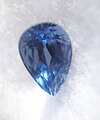






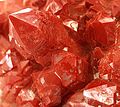






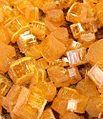


























































![Nesosilicate, garnet, grossular [Ca3Al2(SiO4)3]](http://upload.wikimedia.org/wikipedia/commons/thumb/7/78/Grossular-sio4-alo6-cao8.png/120px-Grossular-sio4-alo6-cao8.png)




